The Impact of Technology on Business Communication
VerifiedAdded on 2020/05/16
|24
|5714
|122
AI Summary
This assignment delves into the profound impact of technological advancements on contemporary business communication. It requires students to analyze how technology has transformed various facets of business communication, such as interpersonal interactions, marketing strategies, and global collaborations. The analysis should encompass both positive and negative effects, considering factors like efficiency, accessibility, and potential challenges related to digital literacy and cybersecurity.
Contribute Materials
Your contribution can guide someone’s learning journey. Share your
documents today.
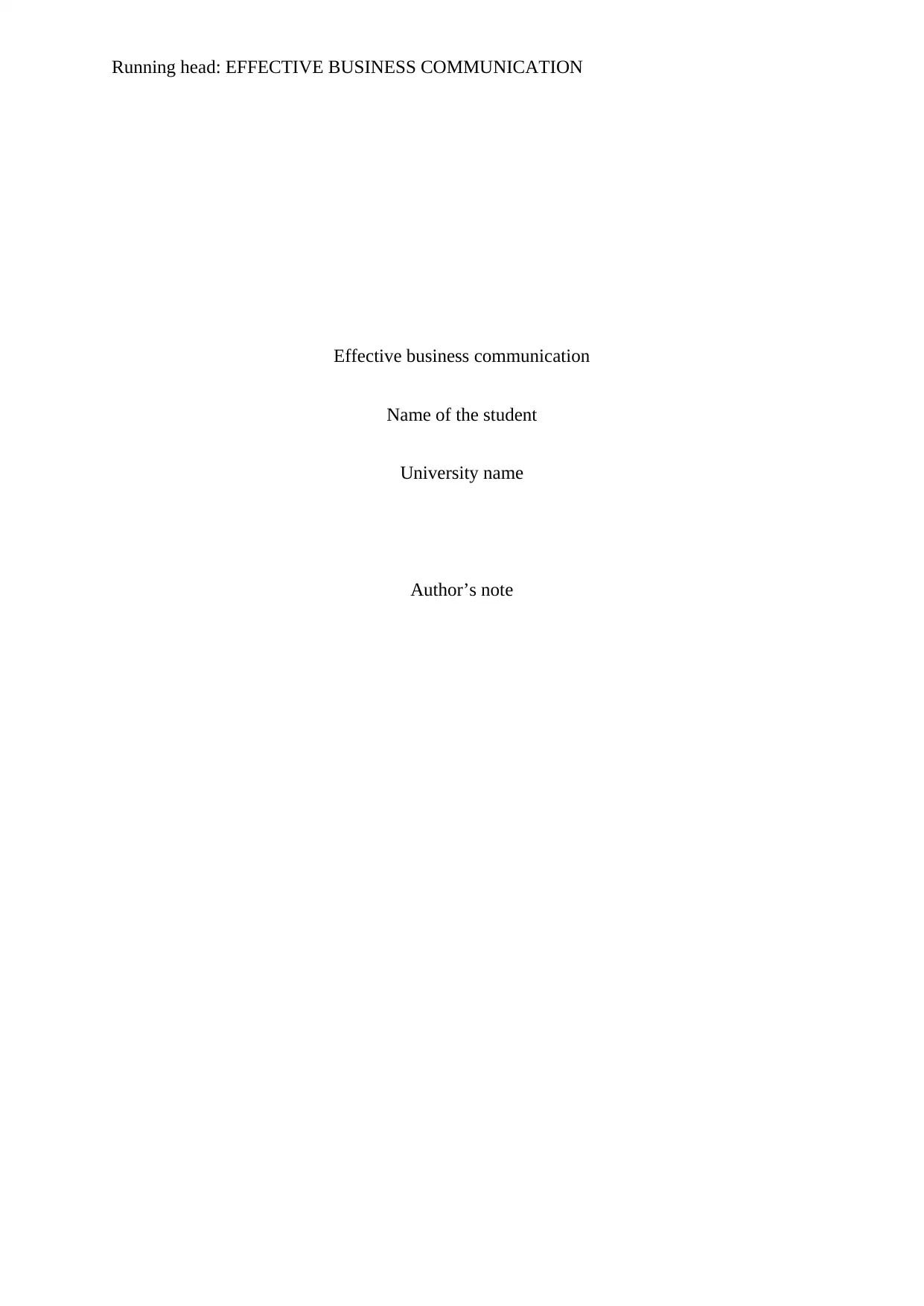
Running head: EFFECTIVE BUSINESS COMMUNICATION
Effective business communication
Name of the student
University name
Author’s note
Effective business communication
Name of the student
University name
Author’s note
Secure Best Marks with AI Grader
Need help grading? Try our AI Grader for instant feedback on your assignments.
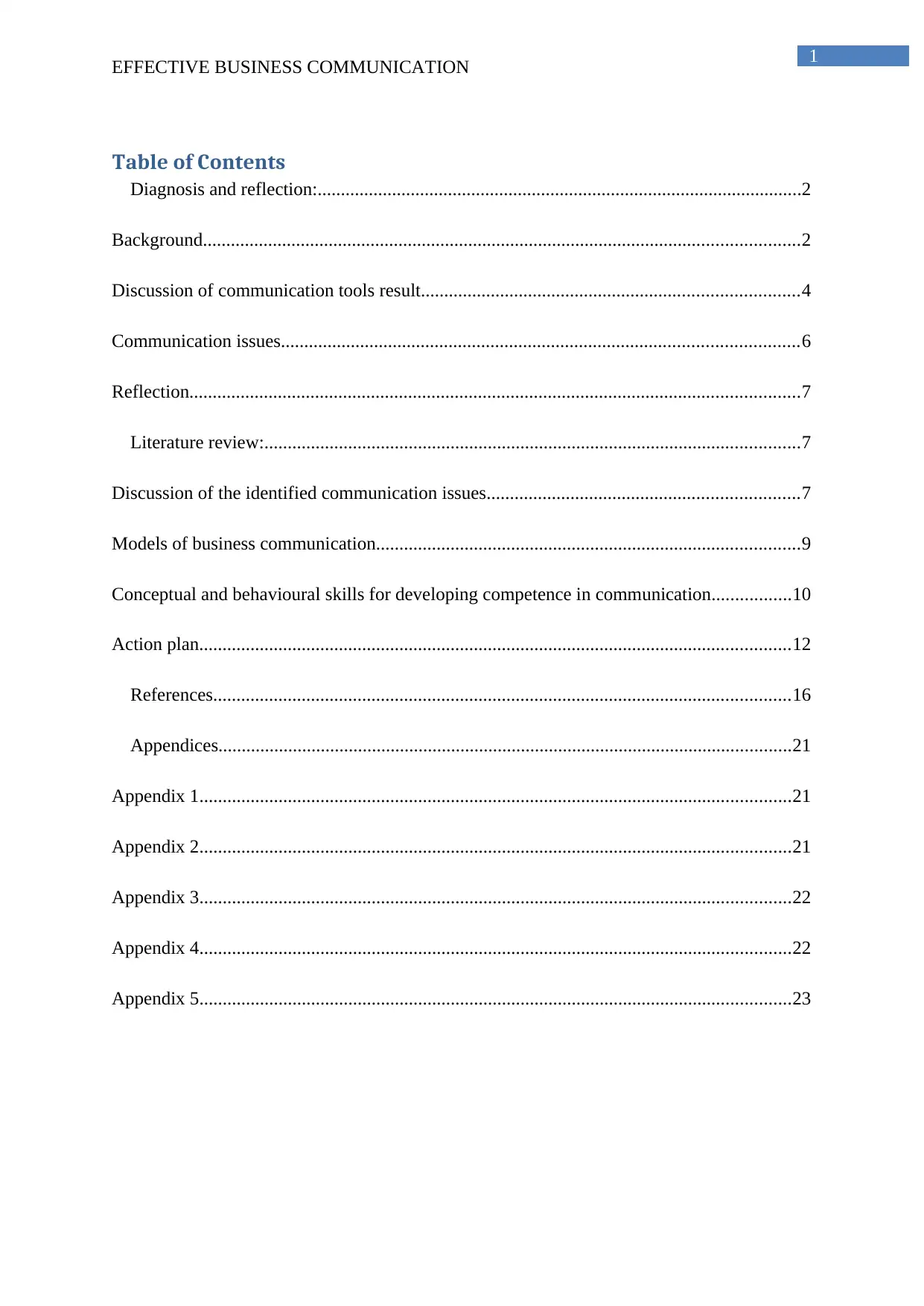
1
EFFECTIVE BUSINESS COMMUNICATION
Table of Contents
Diagnosis and reflection:........................................................................................................2
Background................................................................................................................................2
Discussion of communication tools result.................................................................................4
Communication issues...............................................................................................................6
Reflection...................................................................................................................................7
Literature review:...................................................................................................................7
Discussion of the identified communication issues...................................................................7
Models of business communication...........................................................................................9
Conceptual and behavioural skills for developing competence in communication.................10
Action plan...............................................................................................................................12
References............................................................................................................................16
Appendices...........................................................................................................................21
Appendix 1...............................................................................................................................21
Appendix 2...............................................................................................................................21
Appendix 3...............................................................................................................................22
Appendix 4...............................................................................................................................22
Appendix 5...............................................................................................................................23
EFFECTIVE BUSINESS COMMUNICATION
Table of Contents
Diagnosis and reflection:........................................................................................................2
Background................................................................................................................................2
Discussion of communication tools result.................................................................................4
Communication issues...............................................................................................................6
Reflection...................................................................................................................................7
Literature review:...................................................................................................................7
Discussion of the identified communication issues...................................................................7
Models of business communication...........................................................................................9
Conceptual and behavioural skills for developing competence in communication.................10
Action plan...............................................................................................................................12
References............................................................................................................................16
Appendices...........................................................................................................................21
Appendix 1...............................................................................................................................21
Appendix 2...............................................................................................................................21
Appendix 3...............................................................................................................................22
Appendix 4...............................................................................................................................22
Appendix 5...............................................................................................................................23

2
EFFECTIVE BUSINESS COMMUNICATION
Diagnosis and reflection:
Background
Communication serves as one of the important parameters of effective business
policies and procedures. The communication can be divided into a number of following types
such as- verbal communication, non-verbal communication, active listening etc. The business
communication consists of the guidelines using which the employees, management and
administration interact for reaching the organizational goals. In the current assignment, a
number of communication tools have been used for diagnosis, which helps in analysing the
strengths and gaps of the different communication patterns. In order to make the business
communication effective a number of steps could be undertaken such as the establishment of
a hierarchy, use of visual communication for interaction, etc. As commented by Bovee, Thill
& Raina (2016), effective face to face communication helps in resolution of issues in much
shorter time. Communication serves as the organising element within the business context
and helps in learning about the organizational goals.
In this respect, the Shannon-weaver’s model of communication can be used in order to
explain the physical process of communication. Here, an information source encodes a
message which is transmitted via a channel to the decoder. However as argued by Holmes &
Parker (2017), the message does not reach the decoder in its intact form as it is disrupted by
several barriers within the communication channel. The theory of non-verbal expectations
theory could be further divided into positive and negative violations. It has been seen that
positive violations produce an approved behaviour outcome. The non-verbal communication
proposes an effective exchange of information through the use of proxemics, kinesics and
paralanguage. The proxemics promotes communication through the use of space and
EFFECTIVE BUSINESS COMMUNICATION
Diagnosis and reflection:
Background
Communication serves as one of the important parameters of effective business
policies and procedures. The communication can be divided into a number of following types
such as- verbal communication, non-verbal communication, active listening etc. The business
communication consists of the guidelines using which the employees, management and
administration interact for reaching the organizational goals. In the current assignment, a
number of communication tools have been used for diagnosis, which helps in analysing the
strengths and gaps of the different communication patterns. In order to make the business
communication effective a number of steps could be undertaken such as the establishment of
a hierarchy, use of visual communication for interaction, etc. As commented by Bovee, Thill
& Raina (2016), effective face to face communication helps in resolution of issues in much
shorter time. Communication serves as the organising element within the business context
and helps in learning about the organizational goals.
In this respect, the Shannon-weaver’s model of communication can be used in order to
explain the physical process of communication. Here, an information source encodes a
message which is transmitted via a channel to the decoder. However as argued by Holmes &
Parker (2017), the message does not reach the decoder in its intact form as it is disrupted by
several barriers within the communication channel. The theory of non-verbal expectations
theory could be further divided into positive and negative violations. It has been seen that
positive violations produce an approved behaviour outcome. The non-verbal communication
proposes an effective exchange of information through the use of proxemics, kinesics and
paralanguage. The proxemics promotes communication through the use of space and
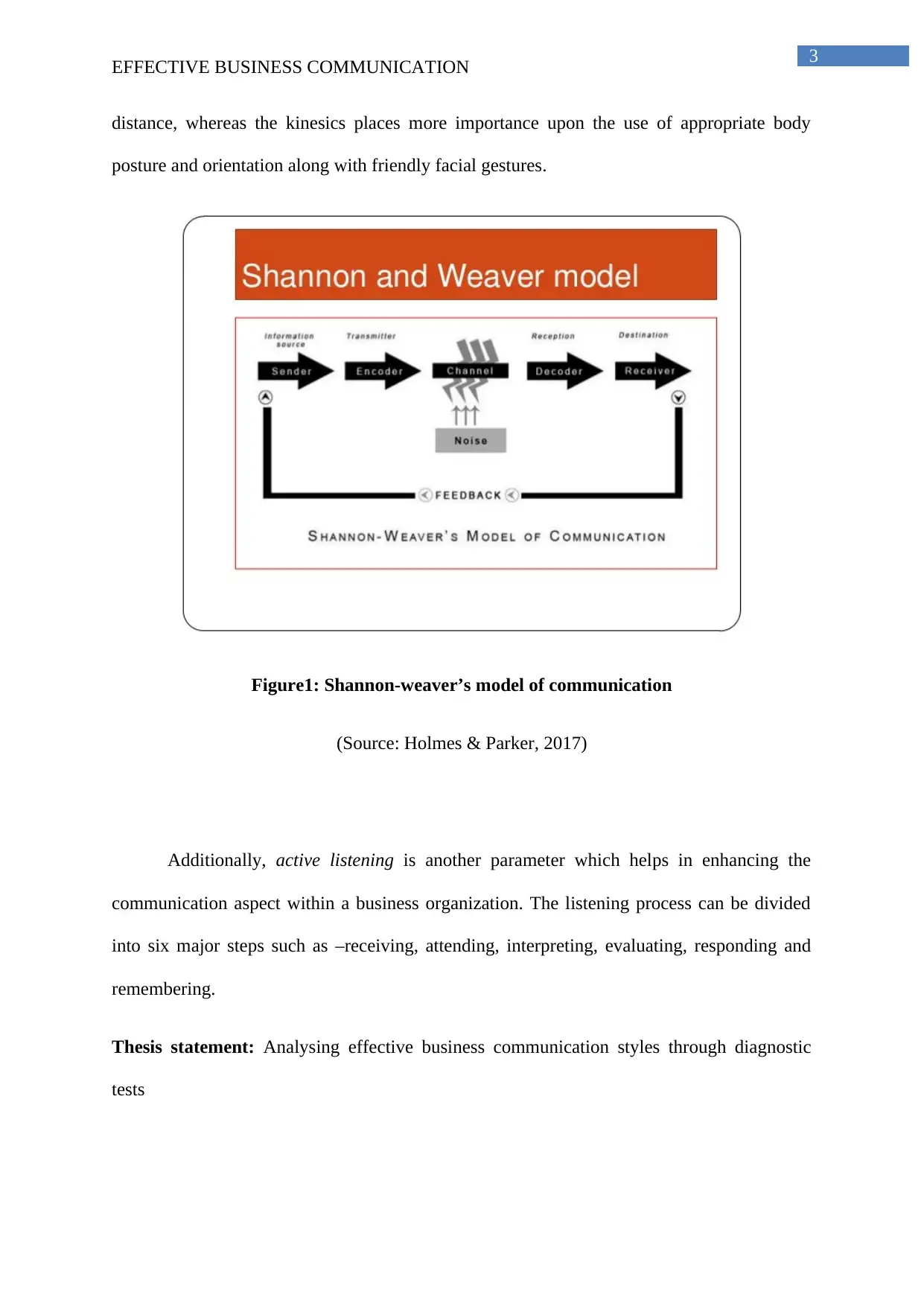
3
EFFECTIVE BUSINESS COMMUNICATION
distance, whereas the kinesics places more importance upon the use of appropriate body
posture and orientation along with friendly facial gestures.
Figure1: Shannon-weaver’s model of communication
(Source: Holmes & Parker, 2017)
Additionally, active listening is another parameter which helps in enhancing the
communication aspect within a business organization. The listening process can be divided
into six major steps such as –receiving, attending, interpreting, evaluating, responding and
remembering.
Thesis statement: Analysing effective business communication styles through diagnostic
tests
EFFECTIVE BUSINESS COMMUNICATION
distance, whereas the kinesics places more importance upon the use of appropriate body
posture and orientation along with friendly facial gestures.
Figure1: Shannon-weaver’s model of communication
(Source: Holmes & Parker, 2017)
Additionally, active listening is another parameter which helps in enhancing the
communication aspect within a business organization. The listening process can be divided
into six major steps such as –receiving, attending, interpreting, evaluating, responding and
remembering.
Thesis statement: Analysing effective business communication styles through diagnostic
tests
Secure Best Marks with AI Grader
Need help grading? Try our AI Grader for instant feedback on your assignments.
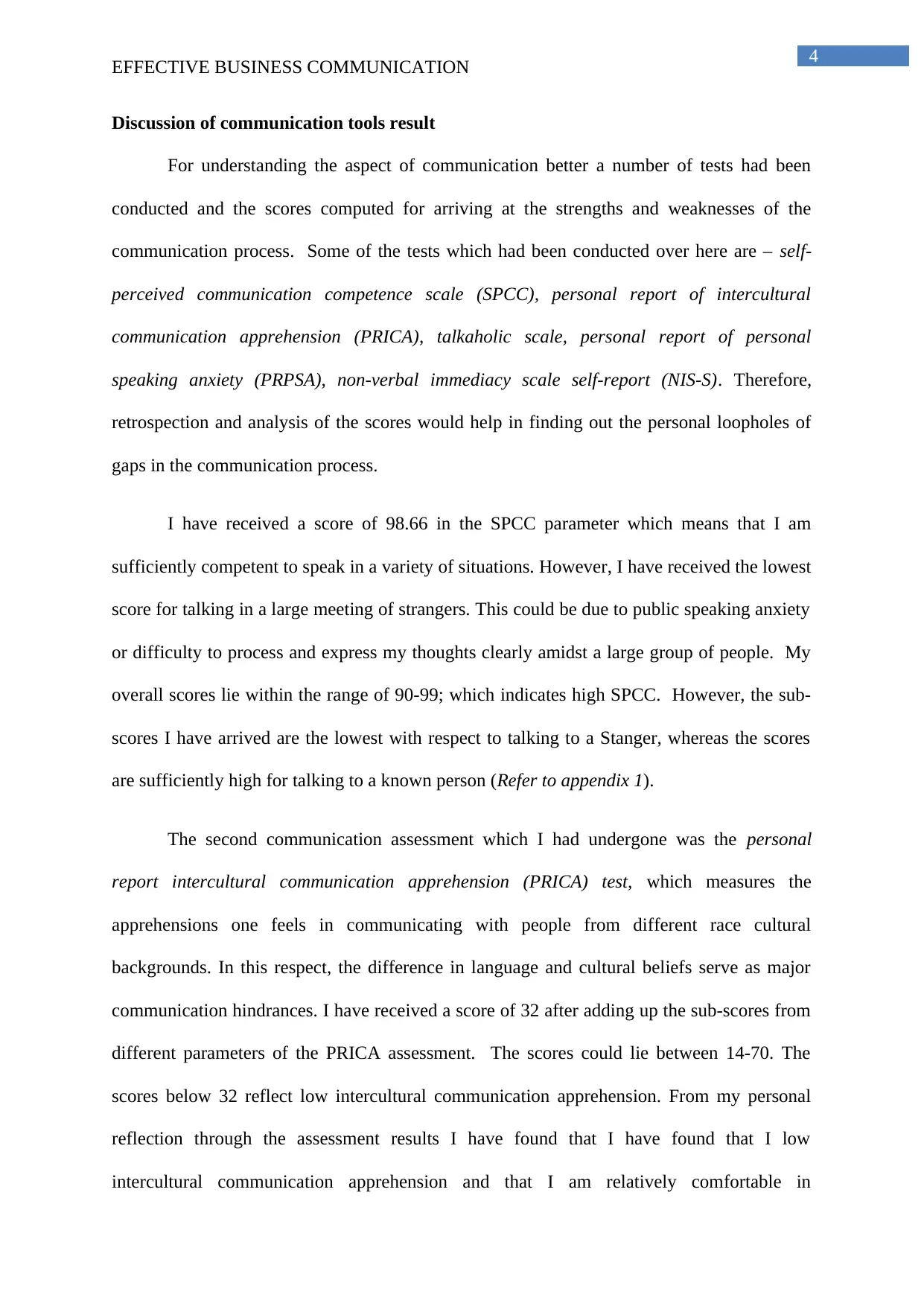
4
EFFECTIVE BUSINESS COMMUNICATION
Discussion of communication tools result
For understanding the aspect of communication better a number of tests had been
conducted and the scores computed for arriving at the strengths and weaknesses of the
communication process. Some of the tests which had been conducted over here are – self-
perceived communication competence scale (SPCC), personal report of intercultural
communication apprehension (PRICA), talkaholic scale, personal report of personal
speaking anxiety (PRPSA), non-verbal immediacy scale self-report (NIS-S). Therefore,
retrospection and analysis of the scores would help in finding out the personal loopholes of
gaps in the communication process.
I have received a score of 98.66 in the SPCC parameter which means that I am
sufficiently competent to speak in a variety of situations. However, I have received the lowest
score for talking in a large meeting of strangers. This could be due to public speaking anxiety
or difficulty to process and express my thoughts clearly amidst a large group of people. My
overall scores lie within the range of 90-99; which indicates high SPCC. However, the sub-
scores I have arrived are the lowest with respect to talking to a Stanger, whereas the scores
are sufficiently high for talking to a known person (Refer to appendix 1).
The second communication assessment which I had undergone was the personal
report intercultural communication apprehension (PRICA) test, which measures the
apprehensions one feels in communicating with people from different race cultural
backgrounds. In this respect, the difference in language and cultural beliefs serve as major
communication hindrances. I have received a score of 32 after adding up the sub-scores from
different parameters of the PRICA assessment. The scores could lie between 14-70. The
scores below 32 reflect low intercultural communication apprehension. From my personal
reflection through the assessment results I have found that I have found that I low
intercultural communication apprehension and that I am relatively comfortable in
EFFECTIVE BUSINESS COMMUNICATION
Discussion of communication tools result
For understanding the aspect of communication better a number of tests had been
conducted and the scores computed for arriving at the strengths and weaknesses of the
communication process. Some of the tests which had been conducted over here are – self-
perceived communication competence scale (SPCC), personal report of intercultural
communication apprehension (PRICA), talkaholic scale, personal report of personal
speaking anxiety (PRPSA), non-verbal immediacy scale self-report (NIS-S). Therefore,
retrospection and analysis of the scores would help in finding out the personal loopholes of
gaps in the communication process.
I have received a score of 98.66 in the SPCC parameter which means that I am
sufficiently competent to speak in a variety of situations. However, I have received the lowest
score for talking in a large meeting of strangers. This could be due to public speaking anxiety
or difficulty to process and express my thoughts clearly amidst a large group of people. My
overall scores lie within the range of 90-99; which indicates high SPCC. However, the sub-
scores I have arrived are the lowest with respect to talking to a Stanger, whereas the scores
are sufficiently high for talking to a known person (Refer to appendix 1).
The second communication assessment which I had undergone was the personal
report intercultural communication apprehension (PRICA) test, which measures the
apprehensions one feels in communicating with people from different race cultural
backgrounds. In this respect, the difference in language and cultural beliefs serve as major
communication hindrances. I have received a score of 32 after adding up the sub-scores from
different parameters of the PRICA assessment. The scores could lie between 14-70. The
scores below 32 reflect low intercultural communication apprehension. From my personal
reflection through the assessment results I have found that I have found that I low
intercultural communication apprehension and that I am relatively comfortable in
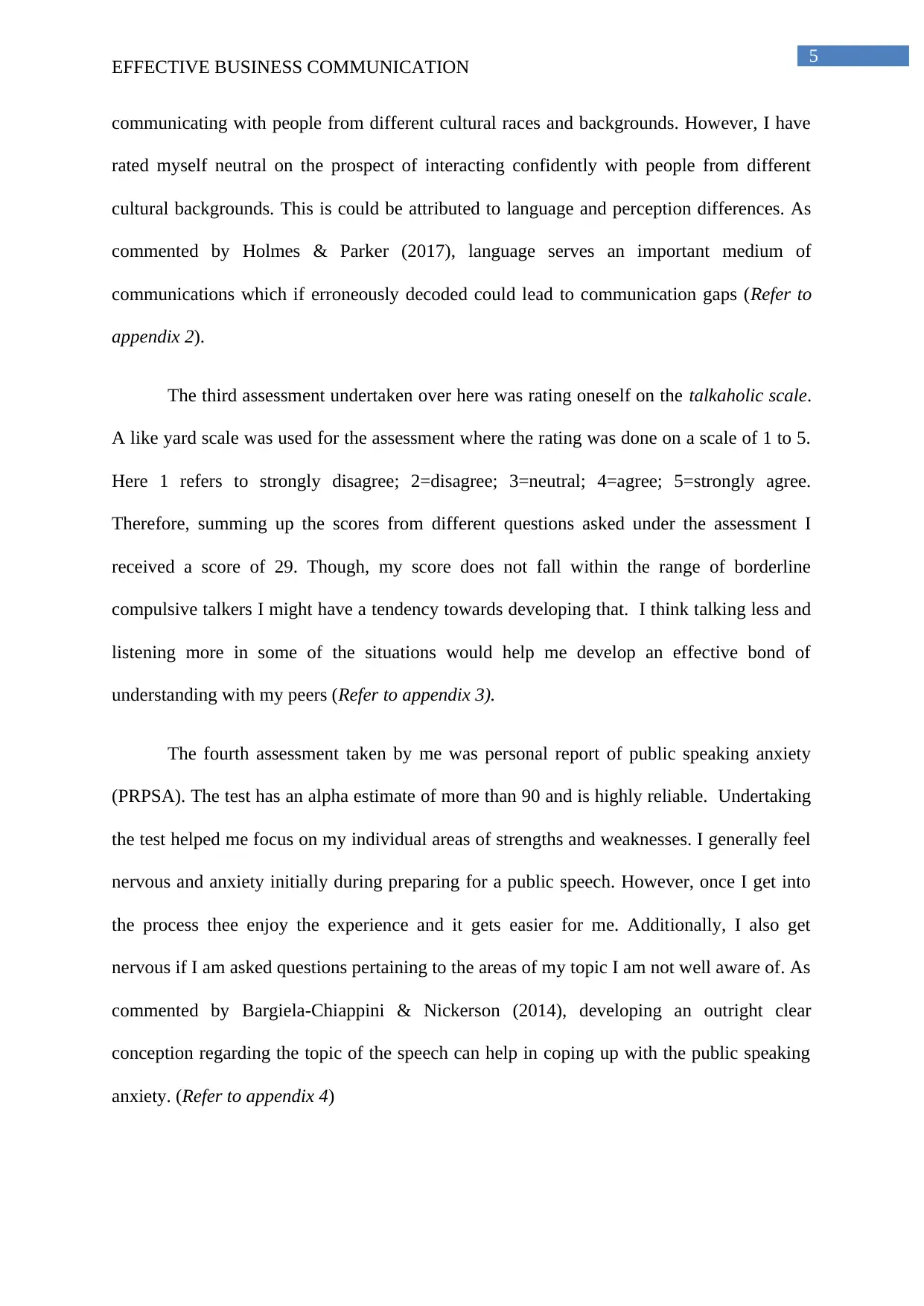
5
EFFECTIVE BUSINESS COMMUNICATION
communicating with people from different cultural races and backgrounds. However, I have
rated myself neutral on the prospect of interacting confidently with people from different
cultural backgrounds. This is could be attributed to language and perception differences. As
commented by Holmes & Parker (2017), language serves an important medium of
communications which if erroneously decoded could lead to communication gaps (Refer to
appendix 2).
The third assessment undertaken over here was rating oneself on the talkaholic scale.
A like yard scale was used for the assessment where the rating was done on a scale of 1 to 5.
Here 1 refers to strongly disagree; 2=disagree; 3=neutral; 4=agree; 5=strongly agree.
Therefore, summing up the scores from different questions asked under the assessment I
received a score of 29. Though, my score does not fall within the range of borderline
compulsive talkers I might have a tendency towards developing that. I think talking less and
listening more in some of the situations would help me develop an effective bond of
understanding with my peers (Refer to appendix 3).
The fourth assessment taken by me was personal report of public speaking anxiety
(PRPSA). The test has an alpha estimate of more than 90 and is highly reliable. Undertaking
the test helped me focus on my individual areas of strengths and weaknesses. I generally feel
nervous and anxiety initially during preparing for a public speech. However, once I get into
the process thee enjoy the experience and it gets easier for me. Additionally, I also get
nervous if I am asked questions pertaining to the areas of my topic I am not well aware of. As
commented by Bargiela-Chiappini & Nickerson (2014), developing an outright clear
conception regarding the topic of the speech can help in coping up with the public speaking
anxiety. (Refer to appendix 4)
EFFECTIVE BUSINESS COMMUNICATION
communicating with people from different cultural races and backgrounds. However, I have
rated myself neutral on the prospect of interacting confidently with people from different
cultural backgrounds. This is could be attributed to language and perception differences. As
commented by Holmes & Parker (2017), language serves an important medium of
communications which if erroneously decoded could lead to communication gaps (Refer to
appendix 2).
The third assessment undertaken over here was rating oneself on the talkaholic scale.
A like yard scale was used for the assessment where the rating was done on a scale of 1 to 5.
Here 1 refers to strongly disagree; 2=disagree; 3=neutral; 4=agree; 5=strongly agree.
Therefore, summing up the scores from different questions asked under the assessment I
received a score of 29. Though, my score does not fall within the range of borderline
compulsive talkers I might have a tendency towards developing that. I think talking less and
listening more in some of the situations would help me develop an effective bond of
understanding with my peers (Refer to appendix 3).
The fourth assessment taken by me was personal report of public speaking anxiety
(PRPSA). The test has an alpha estimate of more than 90 and is highly reliable. Undertaking
the test helped me focus on my individual areas of strengths and weaknesses. I generally feel
nervous and anxiety initially during preparing for a public speech. However, once I get into
the process thee enjoy the experience and it gets easier for me. Additionally, I also get
nervous if I am asked questions pertaining to the areas of my topic I am not well aware of. As
commented by Bargiela-Chiappini & Nickerson (2014), developing an outright clear
conception regarding the topic of the speech can help in coping up with the public speaking
anxiety. (Refer to appendix 4)

6
EFFECTIVE BUSINESS COMMUNICATION
The last diagnostic measurement which was undertaken by me was non-verbal
immediacy scale self-report (NIS-S). The scale helps in measurement of positive behaviour
and responses towards another person. The alpha reliability estimates for the test is expected
to be around 90. I found the method more reliable and valid compared to the prior
assessments as the particular test uses more diverse range of questions to analyse the
approach and behaviour of an individual towards others. The values generated in the report
are statistically significant and socially significant in differentiating between male and
females. That is the females are functionally more articulate and expressive than their male
counterparts with regards to non-verbal communication (Cardon & Marshall, 2015).
However, as argued by Bargiela-Chiappini & Nickerson (2014), the reports may vary
depending on the social situation and the internal nature of the person. I did moderately well
in the NIS-S test where I received a score of 107. However, I rated myself on the neutral side
based upon some of the aspects of the assessment. For example, I maintain a close distance or
sufficient vocal animations while interacting with people only under specific situations.
Therefore, I initiate my communication responses based on the stimulus received (Refer to
appendix 5).
Communication issues
From the analysis of the scores received in the different diagnostic interventions, I
could interpret that I was slightly low on confidence in speaking amongst a large group of
strangers. Additionally, I have received a score of 29 which is only one less than 30, which
means that I could have a tendency for the development of borderline talking. In some of my
recent interactions over the last 12 months, I have felt that I need to develop a strong control
and a sense of confidence in my interactions with others.
EFFECTIVE BUSINESS COMMUNICATION
The last diagnostic measurement which was undertaken by me was non-verbal
immediacy scale self-report (NIS-S). The scale helps in measurement of positive behaviour
and responses towards another person. The alpha reliability estimates for the test is expected
to be around 90. I found the method more reliable and valid compared to the prior
assessments as the particular test uses more diverse range of questions to analyse the
approach and behaviour of an individual towards others. The values generated in the report
are statistically significant and socially significant in differentiating between male and
females. That is the females are functionally more articulate and expressive than their male
counterparts with regards to non-verbal communication (Cardon & Marshall, 2015).
However, as argued by Bargiela-Chiappini & Nickerson (2014), the reports may vary
depending on the social situation and the internal nature of the person. I did moderately well
in the NIS-S test where I received a score of 107. However, I rated myself on the neutral side
based upon some of the aspects of the assessment. For example, I maintain a close distance or
sufficient vocal animations while interacting with people only under specific situations.
Therefore, I initiate my communication responses based on the stimulus received (Refer to
appendix 5).
Communication issues
From the analysis of the scores received in the different diagnostic interventions, I
could interpret that I was slightly low on confidence in speaking amongst a large group of
strangers. Additionally, I have received a score of 29 which is only one less than 30, which
means that I could have a tendency for the development of borderline talking. In some of my
recent interactions over the last 12 months, I have felt that I need to develop a strong control
and a sense of confidence in my interactions with others.
Paraphrase This Document
Need a fresh take? Get an instant paraphrase of this document with our AI Paraphraser
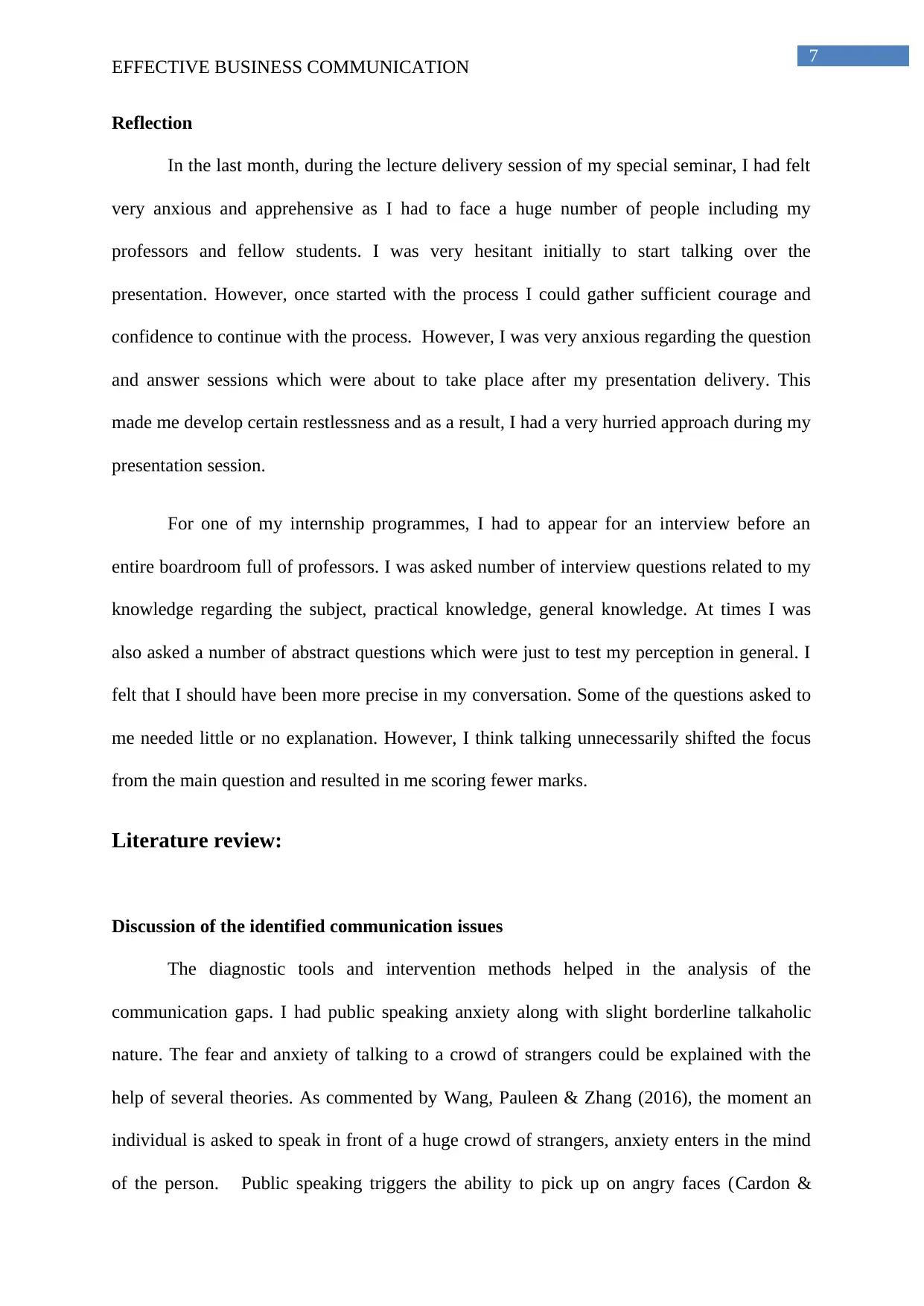
7
EFFECTIVE BUSINESS COMMUNICATION
Reflection
In the last month, during the lecture delivery session of my special seminar, I had felt
very anxious and apprehensive as I had to face a huge number of people including my
professors and fellow students. I was very hesitant initially to start talking over the
presentation. However, once started with the process I could gather sufficient courage and
confidence to continue with the process. However, I was very anxious regarding the question
and answer sessions which were about to take place after my presentation delivery. This
made me develop certain restlessness and as a result, I had a very hurried approach during my
presentation session.
For one of my internship programmes, I had to appear for an interview before an
entire boardroom full of professors. I was asked number of interview questions related to my
knowledge regarding the subject, practical knowledge, general knowledge. At times I was
also asked a number of abstract questions which were just to test my perception in general. I
felt that I should have been more precise in my conversation. Some of the questions asked to
me needed little or no explanation. However, I think talking unnecessarily shifted the focus
from the main question and resulted in me scoring fewer marks.
Literature review:
Discussion of the identified communication issues
The diagnostic tools and intervention methods helped in the analysis of the
communication gaps. I had public speaking anxiety along with slight borderline talkaholic
nature. The fear and anxiety of talking to a crowd of strangers could be explained with the
help of several theories. As commented by Wang, Pauleen & Zhang (2016), the moment an
individual is asked to speak in front of a huge crowd of strangers, anxiety enters in the mind
of the person. Public speaking triggers the ability to pick up on angry faces (Cardon &
EFFECTIVE BUSINESS COMMUNICATION
Reflection
In the last month, during the lecture delivery session of my special seminar, I had felt
very anxious and apprehensive as I had to face a huge number of people including my
professors and fellow students. I was very hesitant initially to start talking over the
presentation. However, once started with the process I could gather sufficient courage and
confidence to continue with the process. However, I was very anxious regarding the question
and answer sessions which were about to take place after my presentation delivery. This
made me develop certain restlessness and as a result, I had a very hurried approach during my
presentation session.
For one of my internship programmes, I had to appear for an interview before an
entire boardroom full of professors. I was asked number of interview questions related to my
knowledge regarding the subject, practical knowledge, general knowledge. At times I was
also asked a number of abstract questions which were just to test my perception in general. I
felt that I should have been more precise in my conversation. Some of the questions asked to
me needed little or no explanation. However, I think talking unnecessarily shifted the focus
from the main question and resulted in me scoring fewer marks.
Literature review:
Discussion of the identified communication issues
The diagnostic tools and intervention methods helped in the analysis of the
communication gaps. I had public speaking anxiety along with slight borderline talkaholic
nature. The fear and anxiety of talking to a crowd of strangers could be explained with the
help of several theories. As commented by Wang, Pauleen & Zhang (2016), the moment an
individual is asked to speak in front of a huge crowd of strangers, anxiety enters in the mind
of the person. Public speaking triggers the ability to pick up on angry faces (Cardon &
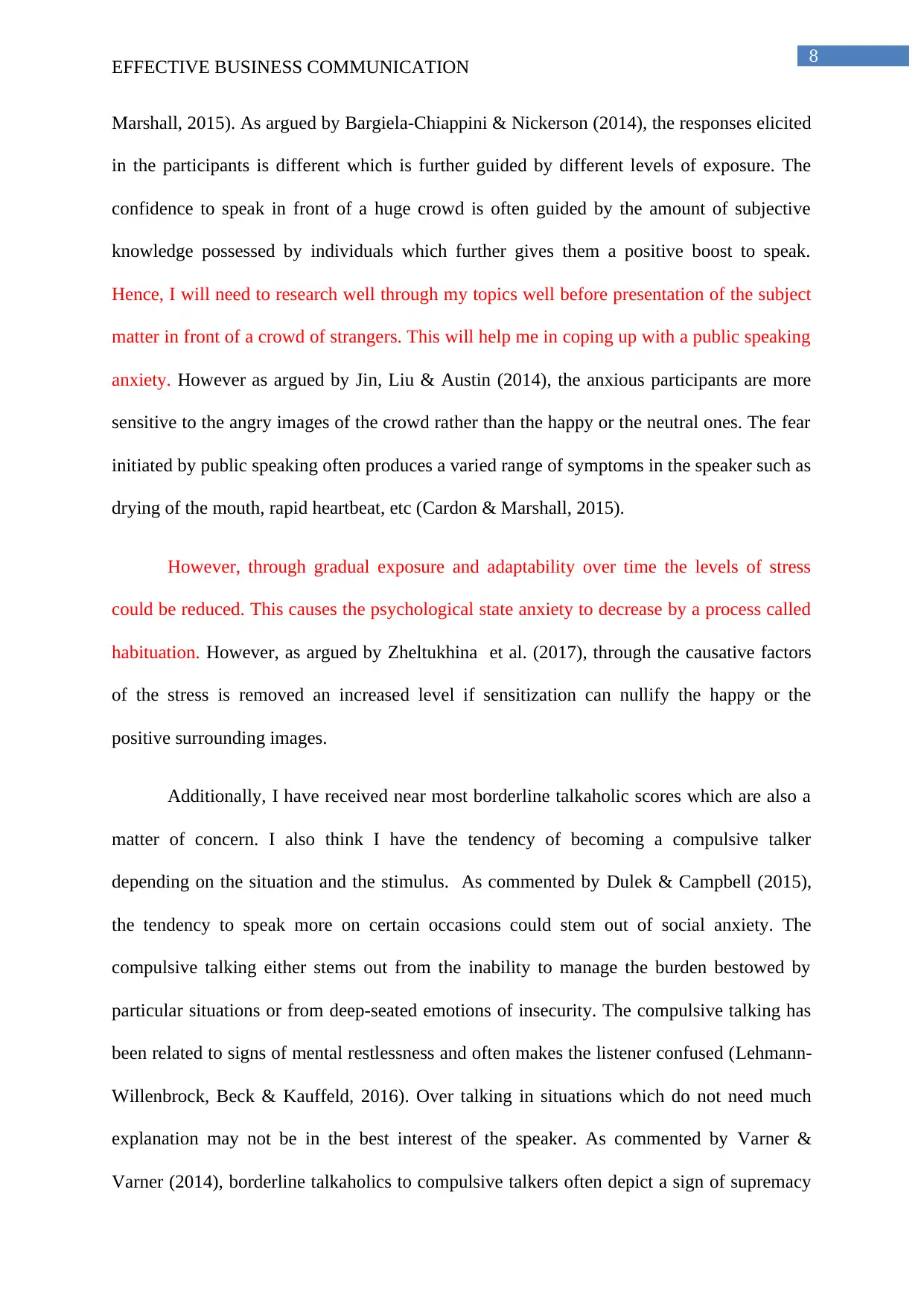
8
EFFECTIVE BUSINESS COMMUNICATION
Marshall, 2015). As argued by Bargiela-Chiappini & Nickerson (2014), the responses elicited
in the participants is different which is further guided by different levels of exposure. The
confidence to speak in front of a huge crowd is often guided by the amount of subjective
knowledge possessed by individuals which further gives them a positive boost to speak.
Hence, I will need to research well through my topics well before presentation of the subject
matter in front of a crowd of strangers. This will help me in coping up with a public speaking
anxiety. However as argued by Jin, Liu & Austin (2014), the anxious participants are more
sensitive to the angry images of the crowd rather than the happy or the neutral ones. The fear
initiated by public speaking often produces a varied range of symptoms in the speaker such as
drying of the mouth, rapid heartbeat, etc (Cardon & Marshall, 2015).
However, through gradual exposure and adaptability over time the levels of stress
could be reduced. This causes the psychological state anxiety to decrease by a process called
habituation. However, as argued by Zheltukhina et al. (2017), through the causative factors
of the stress is removed an increased level if sensitization can nullify the happy or the
positive surrounding images.
Additionally, I have received near most borderline talkaholic scores which are also a
matter of concern. I also think I have the tendency of becoming a compulsive talker
depending on the situation and the stimulus. As commented by Dulek & Campbell (2015),
the tendency to speak more on certain occasions could stem out of social anxiety. The
compulsive talking either stems out from the inability to manage the burden bestowed by
particular situations or from deep-seated emotions of insecurity. The compulsive talking has
been related to signs of mental restlessness and often makes the listener confused (Lehmann-
Willenbrock, Beck & Kauffeld, 2016). Over talking in situations which do not need much
explanation may not be in the best interest of the speaker. As commented by Varner &
Varner (2014), borderline talkaholics to compulsive talkers often depict a sign of supremacy
EFFECTIVE BUSINESS COMMUNICATION
Marshall, 2015). As argued by Bargiela-Chiappini & Nickerson (2014), the responses elicited
in the participants is different which is further guided by different levels of exposure. The
confidence to speak in front of a huge crowd is often guided by the amount of subjective
knowledge possessed by individuals which further gives them a positive boost to speak.
Hence, I will need to research well through my topics well before presentation of the subject
matter in front of a crowd of strangers. This will help me in coping up with a public speaking
anxiety. However as argued by Jin, Liu & Austin (2014), the anxious participants are more
sensitive to the angry images of the crowd rather than the happy or the neutral ones. The fear
initiated by public speaking often produces a varied range of symptoms in the speaker such as
drying of the mouth, rapid heartbeat, etc (Cardon & Marshall, 2015).
However, through gradual exposure and adaptability over time the levels of stress
could be reduced. This causes the psychological state anxiety to decrease by a process called
habituation. However, as argued by Zheltukhina et al. (2017), through the causative factors
of the stress is removed an increased level if sensitization can nullify the happy or the
positive surrounding images.
Additionally, I have received near most borderline talkaholic scores which are also a
matter of concern. I also think I have the tendency of becoming a compulsive talker
depending on the situation and the stimulus. As commented by Dulek & Campbell (2015),
the tendency to speak more on certain occasions could stem out of social anxiety. The
compulsive talking either stems out from the inability to manage the burden bestowed by
particular situations or from deep-seated emotions of insecurity. The compulsive talking has
been related to signs of mental restlessness and often makes the listener confused (Lehmann-
Willenbrock, Beck & Kauffeld, 2016). Over talking in situations which do not need much
explanation may not be in the best interest of the speaker. As commented by Varner &
Varner (2014), borderline talkaholics to compulsive talkers often depict a sign of supremacy

9
EFFECTIVE BUSINESS COMMUNICATION
in their behaviour, which could be attributed to their position within the organization.
Therefore, in order to cope with the compulsion for talking I will need to focus more on the
pathos aspect which will also help me in understanding as well as analysing the thought
process of the listeners.
Models of business communication
The aspect of effective business communication could be described with the help of
several network models. Some of the communication models are – chain network model,
wheel network, circle network, Y network. Depending upon the model of communication
followed the success of an organization is guaranteed. In the centralized chain network, the
information passes from the top to the bottom of the network. As commented by Cornelissen
& Cornelissen (2017), the individual level of satisfaction is moderate over here. However,
much of the information sharing and task allotment under this model of communication is
guided by the organizational ethos and does little to incorporate the self-interests or the
desires of the workers.
The wheel network, on the other hand, shows little or no relation with the different
components within an organization. At this level, the employees are supposed to work more
depending on their individual levels of expertise. As argued by Dulek & Campbell (2015),
this aspect communication is in accordance with the laissez-faire model. In the lack of
responsibility taking, the production of the organization is severely hampered as guidance in
the form of effective communication from the leaders is missing over here. In
decentralization communication network all the members of the group have access to the
same number of communication channels. The equal distribution of resources ensures that
effective information is being transmitted to different channels which will help in addressing
EFFECTIVE BUSINESS COMMUNICATION
in their behaviour, which could be attributed to their position within the organization.
Therefore, in order to cope with the compulsion for talking I will need to focus more on the
pathos aspect which will also help me in understanding as well as analysing the thought
process of the listeners.
Models of business communication
The aspect of effective business communication could be described with the help of
several network models. Some of the communication models are – chain network model,
wheel network, circle network, Y network. Depending upon the model of communication
followed the success of an organization is guaranteed. In the centralized chain network, the
information passes from the top to the bottom of the network. As commented by Cornelissen
& Cornelissen (2017), the individual level of satisfaction is moderate over here. However,
much of the information sharing and task allotment under this model of communication is
guided by the organizational ethos and does little to incorporate the self-interests or the
desires of the workers.
The wheel network, on the other hand, shows little or no relation with the different
components within an organization. At this level, the employees are supposed to work more
depending on their individual levels of expertise. As argued by Dulek & Campbell (2015),
this aspect communication is in accordance with the laissez-faire model. In the lack of
responsibility taking, the production of the organization is severely hampered as guidance in
the form of effective communication from the leaders is missing over here. In
decentralization communication network all the members of the group have access to the
same number of communication channels. The equal distribution of resources ensures that
effective information is being transmitted to different channels which will help in addressing
Secure Best Marks with AI Grader
Need help grading? Try our AI Grader for instant feedback on your assignments.
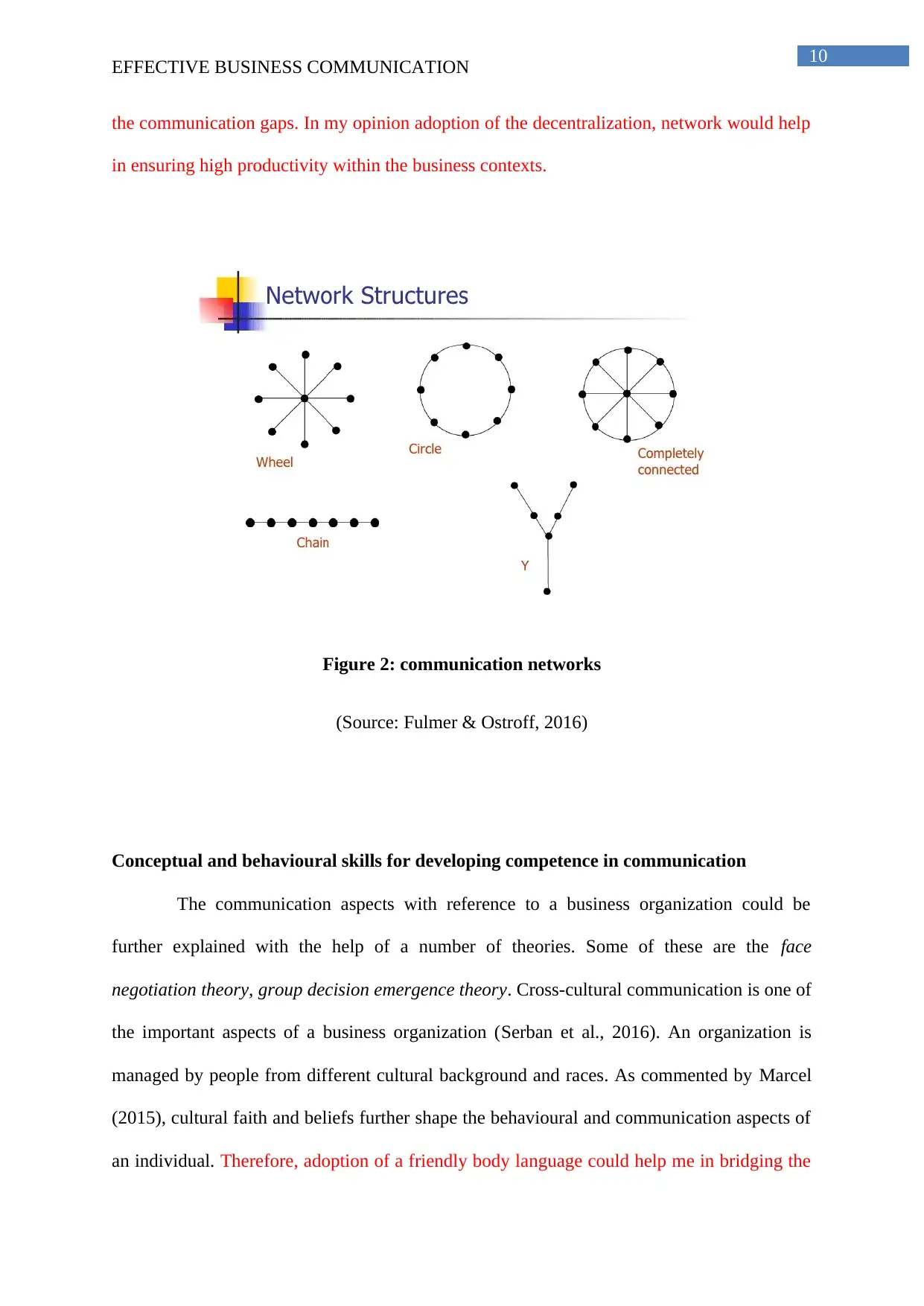
10
EFFECTIVE BUSINESS COMMUNICATION
the communication gaps. In my opinion adoption of the decentralization, network would help
in ensuring high productivity within the business contexts.
Figure 2: communication networks
(Source: Fulmer & Ostroff, 2016)
Conceptual and behavioural skills for developing competence in communication
The communication aspects with reference to a business organization could be
further explained with the help of a number of theories. Some of these are the face
negotiation theory, group decision emergence theory. Cross-cultural communication is one of
the important aspects of a business organization (Serban et al., 2016). An organization is
managed by people from different cultural background and races. As commented by Marcel
(2015), cultural faith and beliefs further shape the behavioural and communication aspects of
an individual. Therefore, adoption of a friendly body language could help me in bridging the
EFFECTIVE BUSINESS COMMUNICATION
the communication gaps. In my opinion adoption of the decentralization, network would help
in ensuring high productivity within the business contexts.
Figure 2: communication networks
(Source: Fulmer & Ostroff, 2016)
Conceptual and behavioural skills for developing competence in communication
The communication aspects with reference to a business organization could be
further explained with the help of a number of theories. Some of these are the face
negotiation theory, group decision emergence theory. Cross-cultural communication is one of
the important aspects of a business organization (Serban et al., 2016). An organization is
managed by people from different cultural background and races. As commented by Marcel
(2015), cultural faith and beliefs further shape the behavioural and communication aspects of
an individual. Therefore, adoption of a friendly body language could help me in bridging the
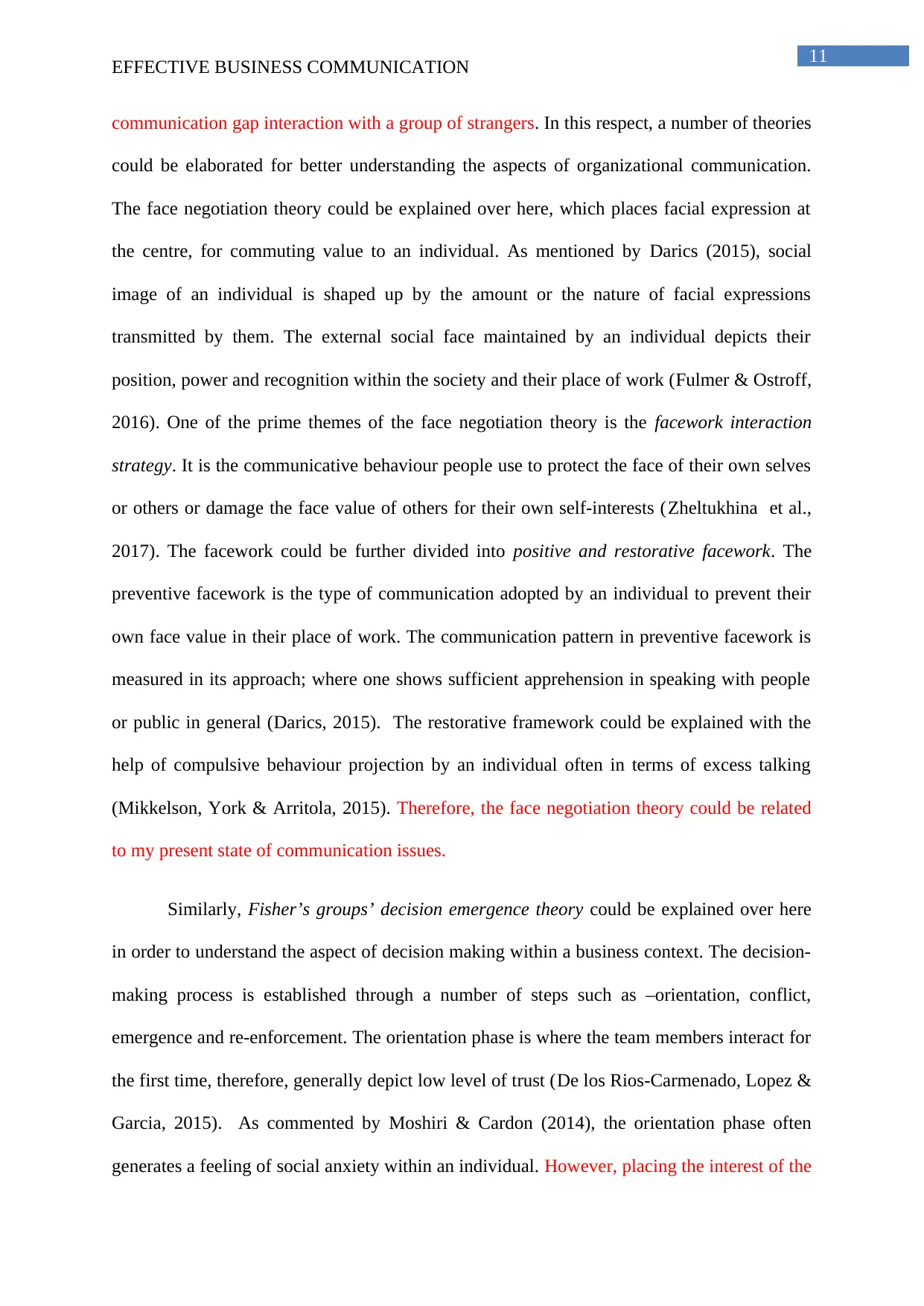
11
EFFECTIVE BUSINESS COMMUNICATION
communication gap interaction with a group of strangers. In this respect, a number of theories
could be elaborated for better understanding the aspects of organizational communication.
The face negotiation theory could be explained over here, which places facial expression at
the centre, for commuting value to an individual. As mentioned by Darics (2015), social
image of an individual is shaped up by the amount or the nature of facial expressions
transmitted by them. The external social face maintained by an individual depicts their
position, power and recognition within the society and their place of work (Fulmer & Ostroff,
2016). One of the prime themes of the face negotiation theory is the facework interaction
strategy. It is the communicative behaviour people use to protect the face of their own selves
or others or damage the face value of others for their own self-interests (Zheltukhina et al.,
2017). The facework could be further divided into positive and restorative facework. The
preventive facework is the type of communication adopted by an individual to prevent their
own face value in their place of work. The communication pattern in preventive facework is
measured in its approach; where one shows sufficient apprehension in speaking with people
or public in general (Darics, 2015). The restorative framework could be explained with the
help of compulsive behaviour projection by an individual often in terms of excess talking
(Mikkelson, York & Arritola, 2015). Therefore, the face negotiation theory could be related
to my present state of communication issues.
Similarly, Fisher’s groups’ decision emergence theory could be explained over here
in order to understand the aspect of decision making within a business context. The decision-
making process is established through a number of steps such as –orientation, conflict,
emergence and re-enforcement. The orientation phase is where the team members interact for
the first time, therefore, generally depict low level of trust (De los Rios-Carmenado, Lopez &
Garcia, 2015). As commented by Moshiri & Cardon (2014), the orientation phase often
generates a feeling of social anxiety within an individual. However, placing the interest of the
EFFECTIVE BUSINESS COMMUNICATION
communication gap interaction with a group of strangers. In this respect, a number of theories
could be elaborated for better understanding the aspects of organizational communication.
The face negotiation theory could be explained over here, which places facial expression at
the centre, for commuting value to an individual. As mentioned by Darics (2015), social
image of an individual is shaped up by the amount or the nature of facial expressions
transmitted by them. The external social face maintained by an individual depicts their
position, power and recognition within the society and their place of work (Fulmer & Ostroff,
2016). One of the prime themes of the face negotiation theory is the facework interaction
strategy. It is the communicative behaviour people use to protect the face of their own selves
or others or damage the face value of others for their own self-interests (Zheltukhina et al.,
2017). The facework could be further divided into positive and restorative facework. The
preventive facework is the type of communication adopted by an individual to prevent their
own face value in their place of work. The communication pattern in preventive facework is
measured in its approach; where one shows sufficient apprehension in speaking with people
or public in general (Darics, 2015). The restorative framework could be explained with the
help of compulsive behaviour projection by an individual often in terms of excess talking
(Mikkelson, York & Arritola, 2015). Therefore, the face negotiation theory could be related
to my present state of communication issues.
Similarly, Fisher’s groups’ decision emergence theory could be explained over here
in order to understand the aspect of decision making within a business context. The decision-
making process is established through a number of steps such as –orientation, conflict,
emergence and re-enforcement. The orientation phase is where the team members interact for
the first time, therefore, generally depict low level of trust (De los Rios-Carmenado, Lopez &
Garcia, 2015). As commented by Moshiri & Cardon (2014), the orientation phase often
generates a feeling of social anxiety within an individual. However, placing the interest of the
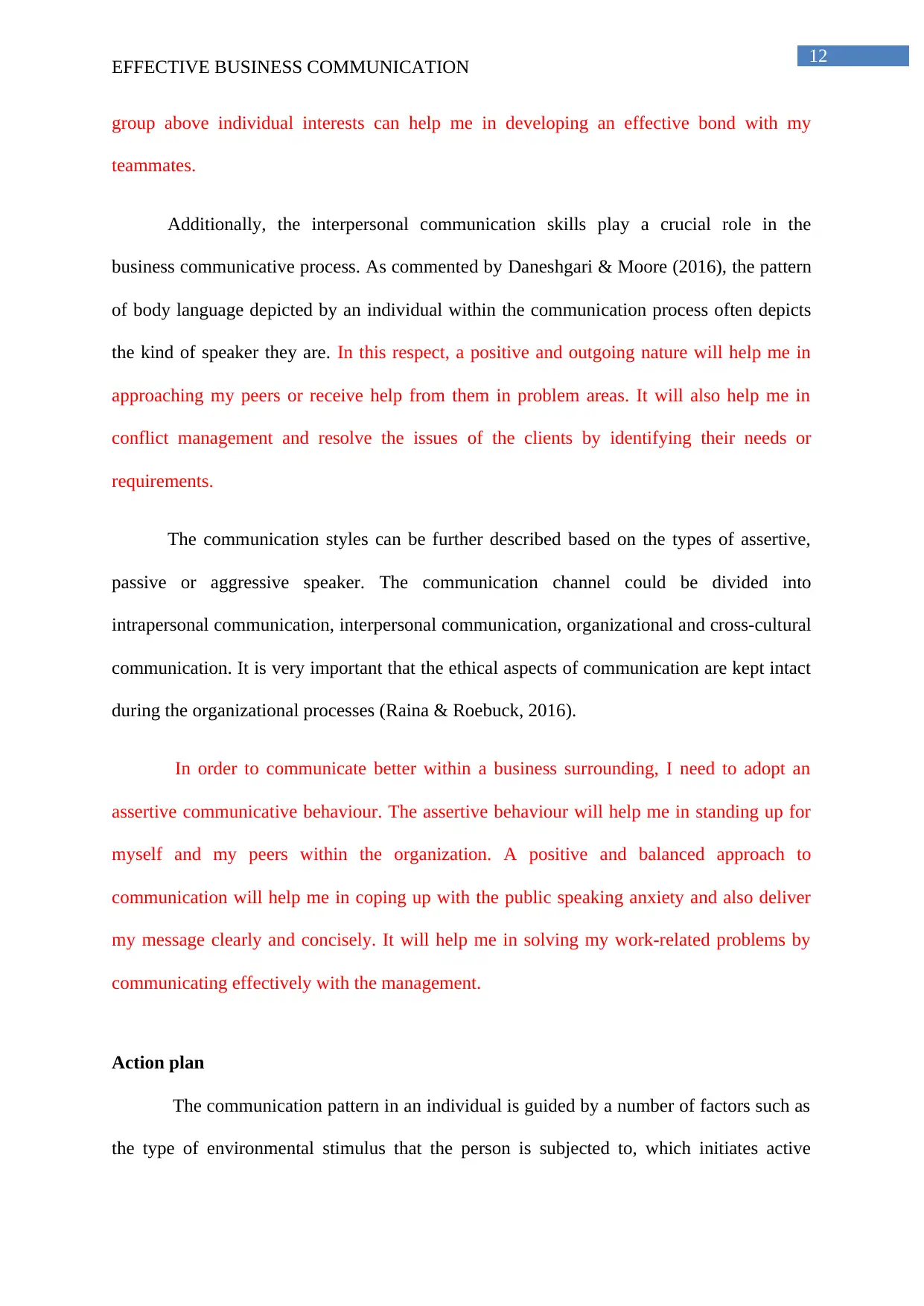
12
EFFECTIVE BUSINESS COMMUNICATION
group above individual interests can help me in developing an effective bond with my
teammates.
Additionally, the interpersonal communication skills play a crucial role in the
business communicative process. As commented by Daneshgari & Moore (2016), the pattern
of body language depicted by an individual within the communication process often depicts
the kind of speaker they are. In this respect, a positive and outgoing nature will help me in
approaching my peers or receive help from them in problem areas. It will also help me in
conflict management and resolve the issues of the clients by identifying their needs or
requirements.
The communication styles can be further described based on the types of assertive,
passive or aggressive speaker. The communication channel could be divided into
intrapersonal communication, interpersonal communication, organizational and cross-cultural
communication. It is very important that the ethical aspects of communication are kept intact
during the organizational processes (Raina & Roebuck, 2016).
In order to communicate better within a business surrounding, I need to adopt an
assertive communicative behaviour. The assertive behaviour will help me in standing up for
myself and my peers within the organization. A positive and balanced approach to
communication will help me in coping up with the public speaking anxiety and also deliver
my message clearly and concisely. It will help me in solving my work-related problems by
communicating effectively with the management.
Action plan
The communication pattern in an individual is guided by a number of factors such as
the type of environmental stimulus that the person is subjected to, which initiates active
EFFECTIVE BUSINESS COMMUNICATION
group above individual interests can help me in developing an effective bond with my
teammates.
Additionally, the interpersonal communication skills play a crucial role in the
business communicative process. As commented by Daneshgari & Moore (2016), the pattern
of body language depicted by an individual within the communication process often depicts
the kind of speaker they are. In this respect, a positive and outgoing nature will help me in
approaching my peers or receive help from them in problem areas. It will also help me in
conflict management and resolve the issues of the clients by identifying their needs or
requirements.
The communication styles can be further described based on the types of assertive,
passive or aggressive speaker. The communication channel could be divided into
intrapersonal communication, interpersonal communication, organizational and cross-cultural
communication. It is very important that the ethical aspects of communication are kept intact
during the organizational processes (Raina & Roebuck, 2016).
In order to communicate better within a business surrounding, I need to adopt an
assertive communicative behaviour. The assertive behaviour will help me in standing up for
myself and my peers within the organization. A positive and balanced approach to
communication will help me in coping up with the public speaking anxiety and also deliver
my message clearly and concisely. It will help me in solving my work-related problems by
communicating effectively with the management.
Action plan
The communication pattern in an individual is guided by a number of factors such as
the type of environmental stimulus that the person is subjected to, which initiates active
Paraphrase This Document
Need a fresh take? Get an instant paraphrase of this document with our AI Paraphraser
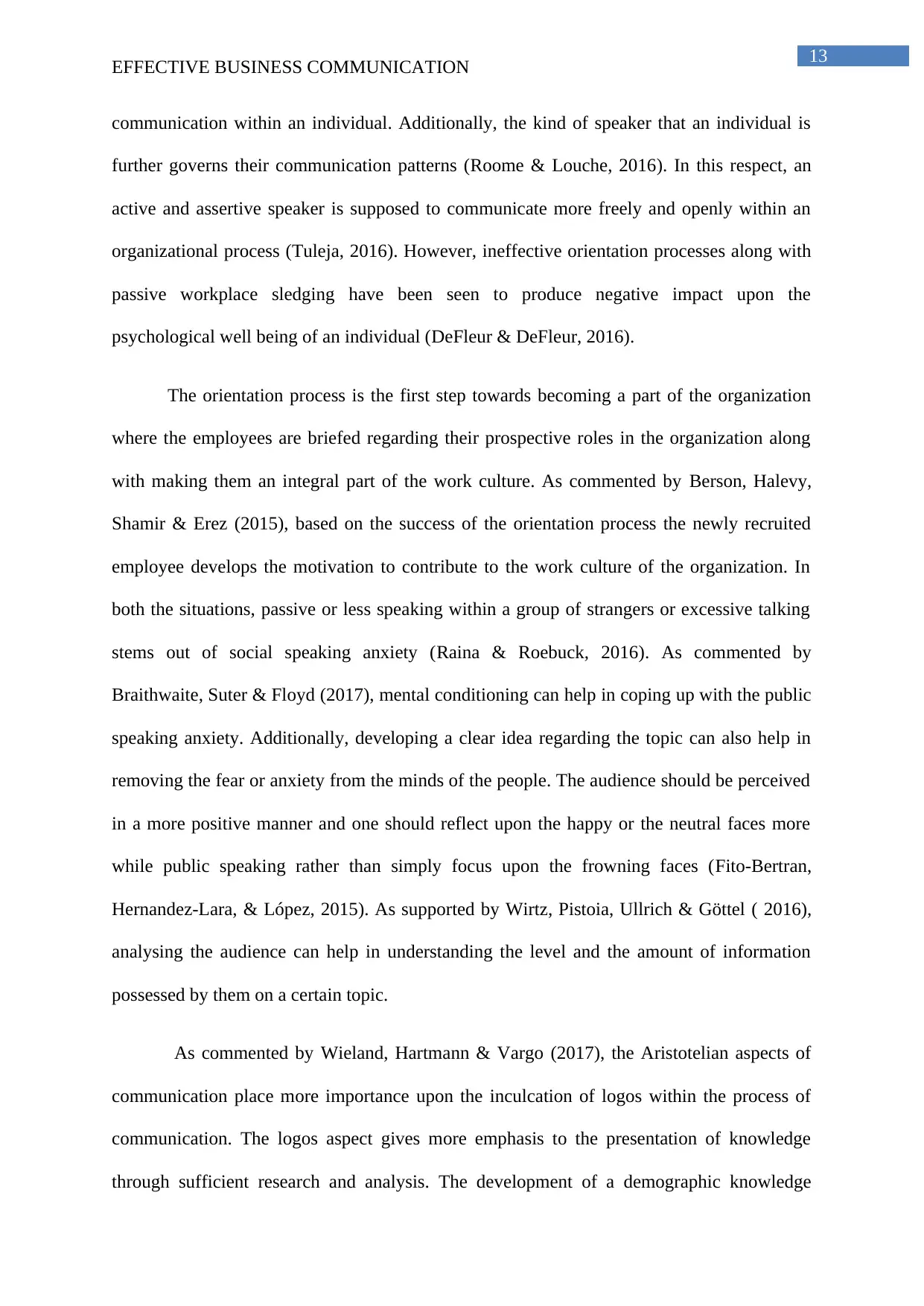
13
EFFECTIVE BUSINESS COMMUNICATION
communication within an individual. Additionally, the kind of speaker that an individual is
further governs their communication patterns (Roome & Louche, 2016). In this respect, an
active and assertive speaker is supposed to communicate more freely and openly within an
organizational process (Tuleja, 2016). However, ineffective orientation processes along with
passive workplace sledging have been seen to produce negative impact upon the
psychological well being of an individual (DeFleur & DeFleur, 2016).
The orientation process is the first step towards becoming a part of the organization
where the employees are briefed regarding their prospective roles in the organization along
with making them an integral part of the work culture. As commented by Berson, Halevy,
Shamir & Erez (2015), based on the success of the orientation process the newly recruited
employee develops the motivation to contribute to the work culture of the organization. In
both the situations, passive or less speaking within a group of strangers or excessive talking
stems out of social speaking anxiety (Raina & Roebuck, 2016). As commented by
Braithwaite, Suter & Floyd (2017), mental conditioning can help in coping up with the public
speaking anxiety. Additionally, developing a clear idea regarding the topic can also help in
removing the fear or anxiety from the minds of the people. The audience should be perceived
in a more positive manner and one should reflect upon the happy or the neutral faces more
while public speaking rather than simply focus upon the frowning faces (Fito-Bertran,
Hernandez-Lara, & López, 2015). As supported by Wirtz, Pistoia, Ullrich & Göttel ( 2016),
analysing the audience can help in understanding the level and the amount of information
possessed by them on a certain topic.
As commented by Wieland, Hartmann & Vargo (2017), the Aristotelian aspects of
communication place more importance upon the inculcation of logos within the process of
communication. The logos aspect gives more emphasis to the presentation of knowledge
through sufficient research and analysis. The development of a demographic knowledge
EFFECTIVE BUSINESS COMMUNICATION
communication within an individual. Additionally, the kind of speaker that an individual is
further governs their communication patterns (Roome & Louche, 2016). In this respect, an
active and assertive speaker is supposed to communicate more freely and openly within an
organizational process (Tuleja, 2016). However, ineffective orientation processes along with
passive workplace sledging have been seen to produce negative impact upon the
psychological well being of an individual (DeFleur & DeFleur, 2016).
The orientation process is the first step towards becoming a part of the organization
where the employees are briefed regarding their prospective roles in the organization along
with making them an integral part of the work culture. As commented by Berson, Halevy,
Shamir & Erez (2015), based on the success of the orientation process the newly recruited
employee develops the motivation to contribute to the work culture of the organization. In
both the situations, passive or less speaking within a group of strangers or excessive talking
stems out of social speaking anxiety (Raina & Roebuck, 2016). As commented by
Braithwaite, Suter & Floyd (2017), mental conditioning can help in coping up with the public
speaking anxiety. Additionally, developing a clear idea regarding the topic can also help in
removing the fear or anxiety from the minds of the people. The audience should be perceived
in a more positive manner and one should reflect upon the happy or the neutral faces more
while public speaking rather than simply focus upon the frowning faces (Fito-Bertran,
Hernandez-Lara, & López, 2015). As supported by Wirtz, Pistoia, Ullrich & Göttel ( 2016),
analysing the audience can help in understanding the level and the amount of information
possessed by them on a certain topic.
As commented by Wieland, Hartmann & Vargo (2017), the Aristotelian aspects of
communication place more importance upon the inculcation of logos within the process of
communication. The logos aspect gives more emphasis to the presentation of knowledge
through sufficient research and analysis. The development of a demographic knowledge
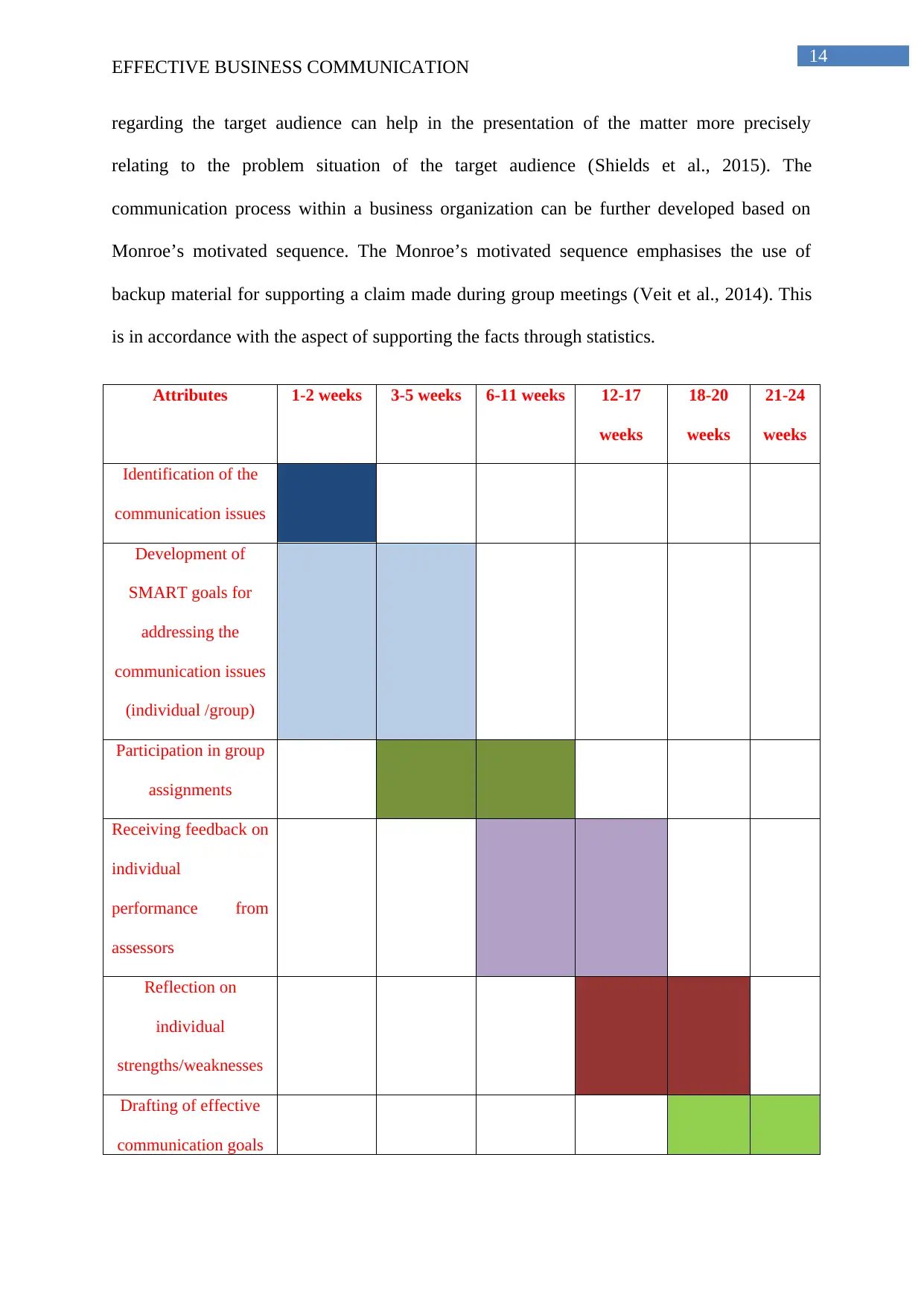
14
EFFECTIVE BUSINESS COMMUNICATION
regarding the target audience can help in the presentation of the matter more precisely
relating to the problem situation of the target audience (Shields et al., 2015). The
communication process within a business organization can be further developed based on
Monroe’s motivated sequence. The Monroe’s motivated sequence emphasises the use of
backup material for supporting a claim made during group meetings (Veit et al., 2014). This
is in accordance with the aspect of supporting the facts through statistics.
Attributes 1-2 weeks 3-5 weeks 6-11 weeks 12-17
weeks
18-20
weeks
21-24
weeks
Identification of the
communication issues
Development of
SMART goals for
addressing the
communication issues
(individual /group)
Participation in group
assignments
Receiving feedback on
individual
performance from
assessors
Reflection on
individual
strengths/weaknesses
Drafting of effective
communication goals
EFFECTIVE BUSINESS COMMUNICATION
regarding the target audience can help in the presentation of the matter more precisely
relating to the problem situation of the target audience (Shields et al., 2015). The
communication process within a business organization can be further developed based on
Monroe’s motivated sequence. The Monroe’s motivated sequence emphasises the use of
backup material for supporting a claim made during group meetings (Veit et al., 2014). This
is in accordance with the aspect of supporting the facts through statistics.
Attributes 1-2 weeks 3-5 weeks 6-11 weeks 12-17
weeks
18-20
weeks
21-24
weeks
Identification of the
communication issues
Development of
SMART goals for
addressing the
communication issues
(individual /group)
Participation in group
assignments
Receiving feedback on
individual
performance from
assessors
Reflection on
individual
strengths/weaknesses
Drafting of effective
communication goals
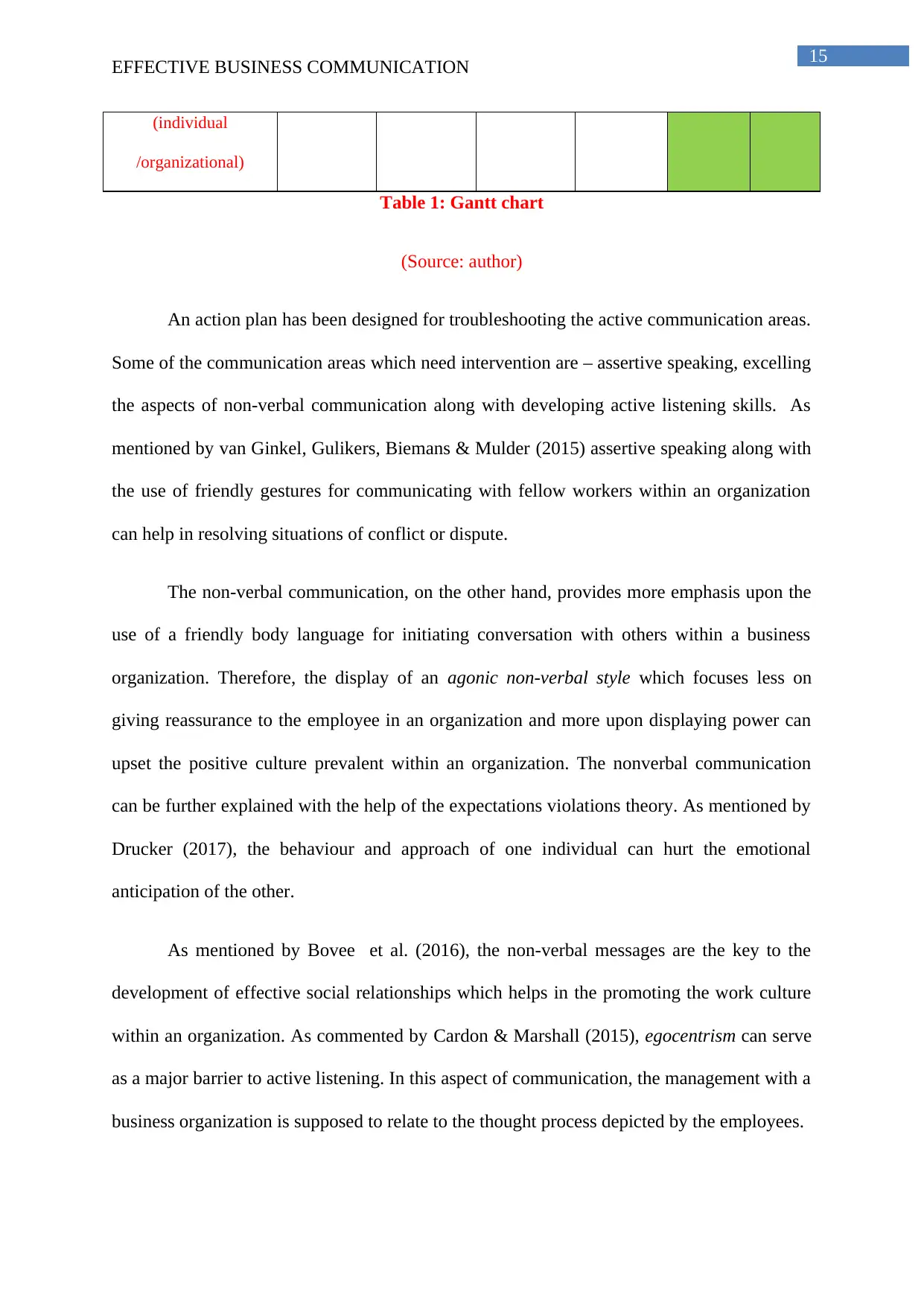
15
EFFECTIVE BUSINESS COMMUNICATION
(individual
/organizational)
Table 1: Gantt chart
(Source: author)
An action plan has been designed for troubleshooting the active communication areas.
Some of the communication areas which need intervention are – assertive speaking, excelling
the aspects of non-verbal communication along with developing active listening skills. As
mentioned by van Ginkel, Gulikers, Biemans & Mulder (2015) assertive speaking along with
the use of friendly gestures for communicating with fellow workers within an organization
can help in resolving situations of conflict or dispute.
The non-verbal communication, on the other hand, provides more emphasis upon the
use of a friendly body language for initiating conversation with others within a business
organization. Therefore, the display of an agonic non-verbal style which focuses less on
giving reassurance to the employee in an organization and more upon displaying power can
upset the positive culture prevalent within an organization. The nonverbal communication
can be further explained with the help of the expectations violations theory. As mentioned by
Drucker (2017), the behaviour and approach of one individual can hurt the emotional
anticipation of the other.
As mentioned by Bovee et al. (2016), the non-verbal messages are the key to the
development of effective social relationships which helps in the promoting the work culture
within an organization. As commented by Cardon & Marshall (2015), egocentrism can serve
as a major barrier to active listening. In this aspect of communication, the management with a
business organization is supposed to relate to the thought process depicted by the employees.
EFFECTIVE BUSINESS COMMUNICATION
(individual
/organizational)
Table 1: Gantt chart
(Source: author)
An action plan has been designed for troubleshooting the active communication areas.
Some of the communication areas which need intervention are – assertive speaking, excelling
the aspects of non-verbal communication along with developing active listening skills. As
mentioned by van Ginkel, Gulikers, Biemans & Mulder (2015) assertive speaking along with
the use of friendly gestures for communicating with fellow workers within an organization
can help in resolving situations of conflict or dispute.
The non-verbal communication, on the other hand, provides more emphasis upon the
use of a friendly body language for initiating conversation with others within a business
organization. Therefore, the display of an agonic non-verbal style which focuses less on
giving reassurance to the employee in an organization and more upon displaying power can
upset the positive culture prevalent within an organization. The nonverbal communication
can be further explained with the help of the expectations violations theory. As mentioned by
Drucker (2017), the behaviour and approach of one individual can hurt the emotional
anticipation of the other.
As mentioned by Bovee et al. (2016), the non-verbal messages are the key to the
development of effective social relationships which helps in the promoting the work culture
within an organization. As commented by Cardon & Marshall (2015), egocentrism can serve
as a major barrier to active listening. In this aspect of communication, the management with a
business organization is supposed to relate to the thought process depicted by the employees.
Secure Best Marks with AI Grader
Need help grading? Try our AI Grader for instant feedback on your assignments.
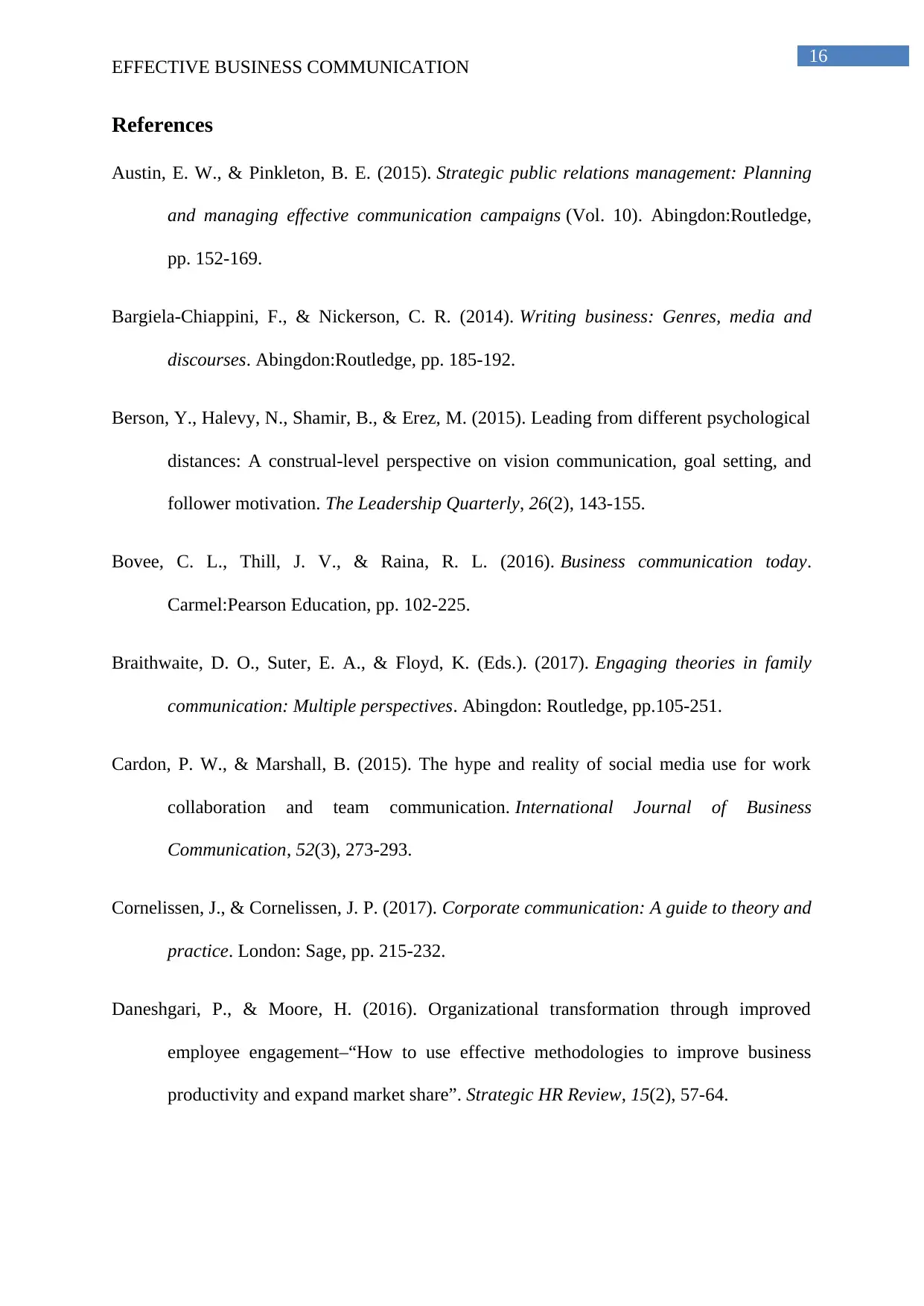
16
EFFECTIVE BUSINESS COMMUNICATION
References
Austin, E. W., & Pinkleton, B. E. (2015). Strategic public relations management: Planning
and managing effective communication campaigns (Vol. 10). Abingdon:Routledge,
pp. 152-169.
Bargiela-Chiappini, F., & Nickerson, C. R. (2014). Writing business: Genres, media and
discourses. Abingdon:Routledge, pp. 185-192.
Berson, Y., Halevy, N., Shamir, B., & Erez, M. (2015). Leading from different psychological
distances: A construal-level perspective on vision communication, goal setting, and
follower motivation. The Leadership Quarterly, 26(2), 143-155.
Bovee, C. L., Thill, J. V., & Raina, R. L. (2016). Business communication today.
Carmel:Pearson Education, pp. 102-225.
Braithwaite, D. O., Suter, E. A., & Floyd, K. (Eds.). (2017). Engaging theories in family
communication: Multiple perspectives. Abingdon: Routledge, pp.105-251.
Cardon, P. W., & Marshall, B. (2015). The hype and reality of social media use for work
collaboration and team communication. International Journal of Business
Communication, 52(3), 273-293.
Cornelissen, J., & Cornelissen, J. P. (2017). Corporate communication: A guide to theory and
practice. London: Sage, pp. 215-232.
Daneshgari, P., & Moore, H. (2016). Organizational transformation through improved
employee engagement–“How to use effective methodologies to improve business
productivity and expand market share”. Strategic HR Review, 15(2), 57-64.
EFFECTIVE BUSINESS COMMUNICATION
References
Austin, E. W., & Pinkleton, B. E. (2015). Strategic public relations management: Planning
and managing effective communication campaigns (Vol. 10). Abingdon:Routledge,
pp. 152-169.
Bargiela-Chiappini, F., & Nickerson, C. R. (2014). Writing business: Genres, media and
discourses. Abingdon:Routledge, pp. 185-192.
Berson, Y., Halevy, N., Shamir, B., & Erez, M. (2015). Leading from different psychological
distances: A construal-level perspective on vision communication, goal setting, and
follower motivation. The Leadership Quarterly, 26(2), 143-155.
Bovee, C. L., Thill, J. V., & Raina, R. L. (2016). Business communication today.
Carmel:Pearson Education, pp. 102-225.
Braithwaite, D. O., Suter, E. A., & Floyd, K. (Eds.). (2017). Engaging theories in family
communication: Multiple perspectives. Abingdon: Routledge, pp.105-251.
Cardon, P. W., & Marshall, B. (2015). The hype and reality of social media use for work
collaboration and team communication. International Journal of Business
Communication, 52(3), 273-293.
Cornelissen, J., & Cornelissen, J. P. (2017). Corporate communication: A guide to theory and
practice. London: Sage, pp. 215-232.
Daneshgari, P., & Moore, H. (2016). Organizational transformation through improved
employee engagement–“How to use effective methodologies to improve business
productivity and expand market share”. Strategic HR Review, 15(2), 57-64.
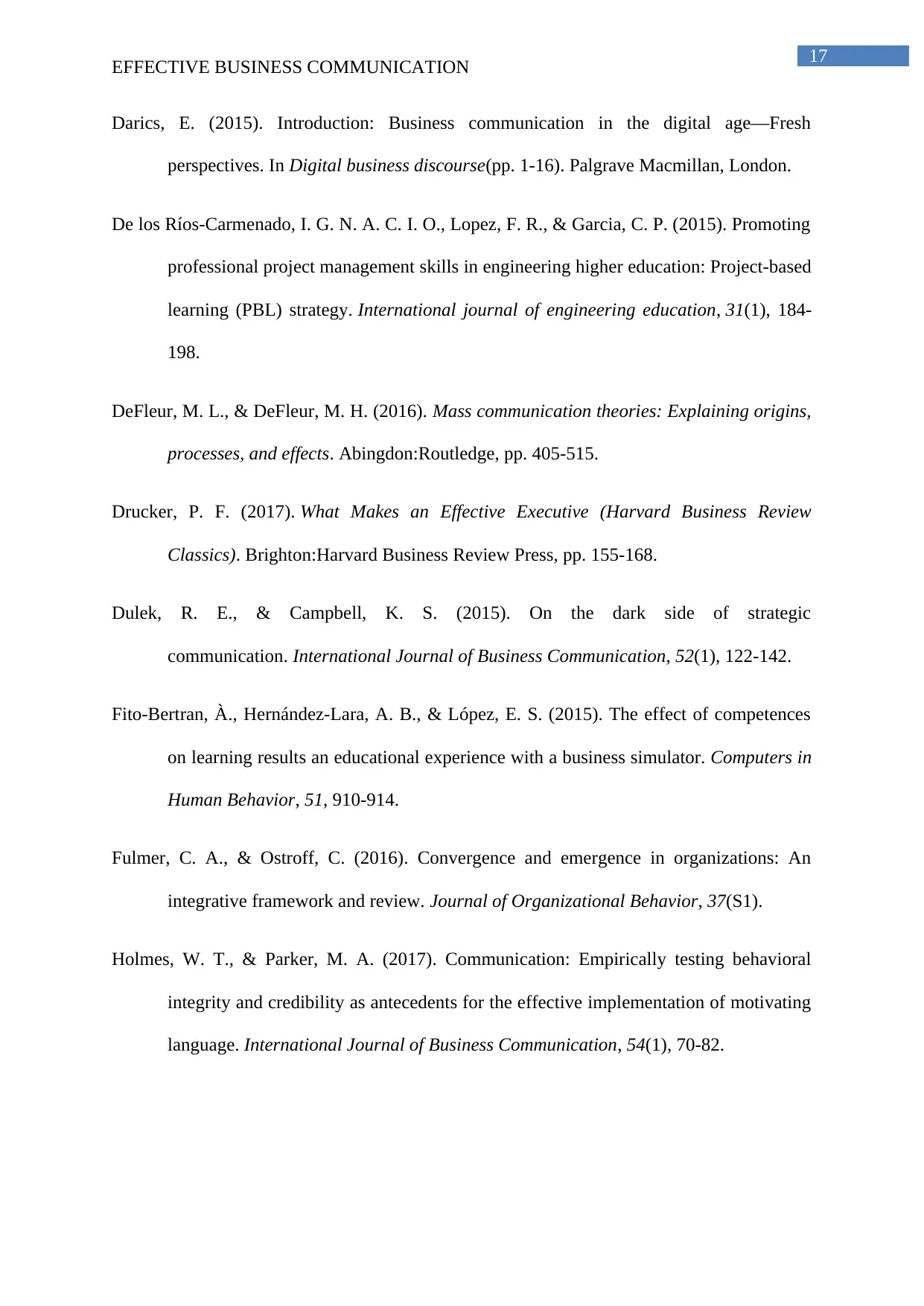
17
EFFECTIVE BUSINESS COMMUNICATION
Darics, E. (2015). Introduction: Business communication in the digital age—Fresh
perspectives. In Digital business discourse(pp. 1-16). Palgrave Macmillan, London.
De los Ríos-Carmenado, I. G. N. A. C. I. O., Lopez, F. R., & Garcia, C. P. (2015). Promoting
professional project management skills in engineering higher education: Project-based
learning (PBL) strategy. International journal of engineering education, 31(1), 184-
198.
DeFleur, M. L., & DeFleur, M. H. (2016). Mass communication theories: Explaining origins,
processes, and effects. Abingdon:Routledge, pp. 405-515.
Drucker, P. F. (2017). What Makes an Effective Executive (Harvard Business Review
Classics). Brighton:Harvard Business Review Press, pp. 155-168.
Dulek, R. E., & Campbell, K. S. (2015). On the dark side of strategic
communication. International Journal of Business Communication, 52(1), 122-142.
Fito-Bertran, À., Hernández-Lara, A. B., & López, E. S. (2015). The effect of competences
on learning results an educational experience with a business simulator. Computers in
Human Behavior, 51, 910-914.
Fulmer, C. A., & Ostroff, C. (2016). Convergence and emergence in organizations: An
integrative framework and review. Journal of Organizational Behavior, 37(S1).
Holmes, W. T., & Parker, M. A. (2017). Communication: Empirically testing behavioral
integrity and credibility as antecedents for the effective implementation of motivating
language. International Journal of Business Communication, 54(1), 70-82.
EFFECTIVE BUSINESS COMMUNICATION
Darics, E. (2015). Introduction: Business communication in the digital age—Fresh
perspectives. In Digital business discourse(pp. 1-16). Palgrave Macmillan, London.
De los Ríos-Carmenado, I. G. N. A. C. I. O., Lopez, F. R., & Garcia, C. P. (2015). Promoting
professional project management skills in engineering higher education: Project-based
learning (PBL) strategy. International journal of engineering education, 31(1), 184-
198.
DeFleur, M. L., & DeFleur, M. H. (2016). Mass communication theories: Explaining origins,
processes, and effects. Abingdon:Routledge, pp. 405-515.
Drucker, P. F. (2017). What Makes an Effective Executive (Harvard Business Review
Classics). Brighton:Harvard Business Review Press, pp. 155-168.
Dulek, R. E., & Campbell, K. S. (2015). On the dark side of strategic
communication. International Journal of Business Communication, 52(1), 122-142.
Fito-Bertran, À., Hernández-Lara, A. B., & López, E. S. (2015). The effect of competences
on learning results an educational experience with a business simulator. Computers in
Human Behavior, 51, 910-914.
Fulmer, C. A., & Ostroff, C. (2016). Convergence and emergence in organizations: An
integrative framework and review. Journal of Organizational Behavior, 37(S1).
Holmes, W. T., & Parker, M. A. (2017). Communication: Empirically testing behavioral
integrity and credibility as antecedents for the effective implementation of motivating
language. International Journal of Business Communication, 54(1), 70-82.
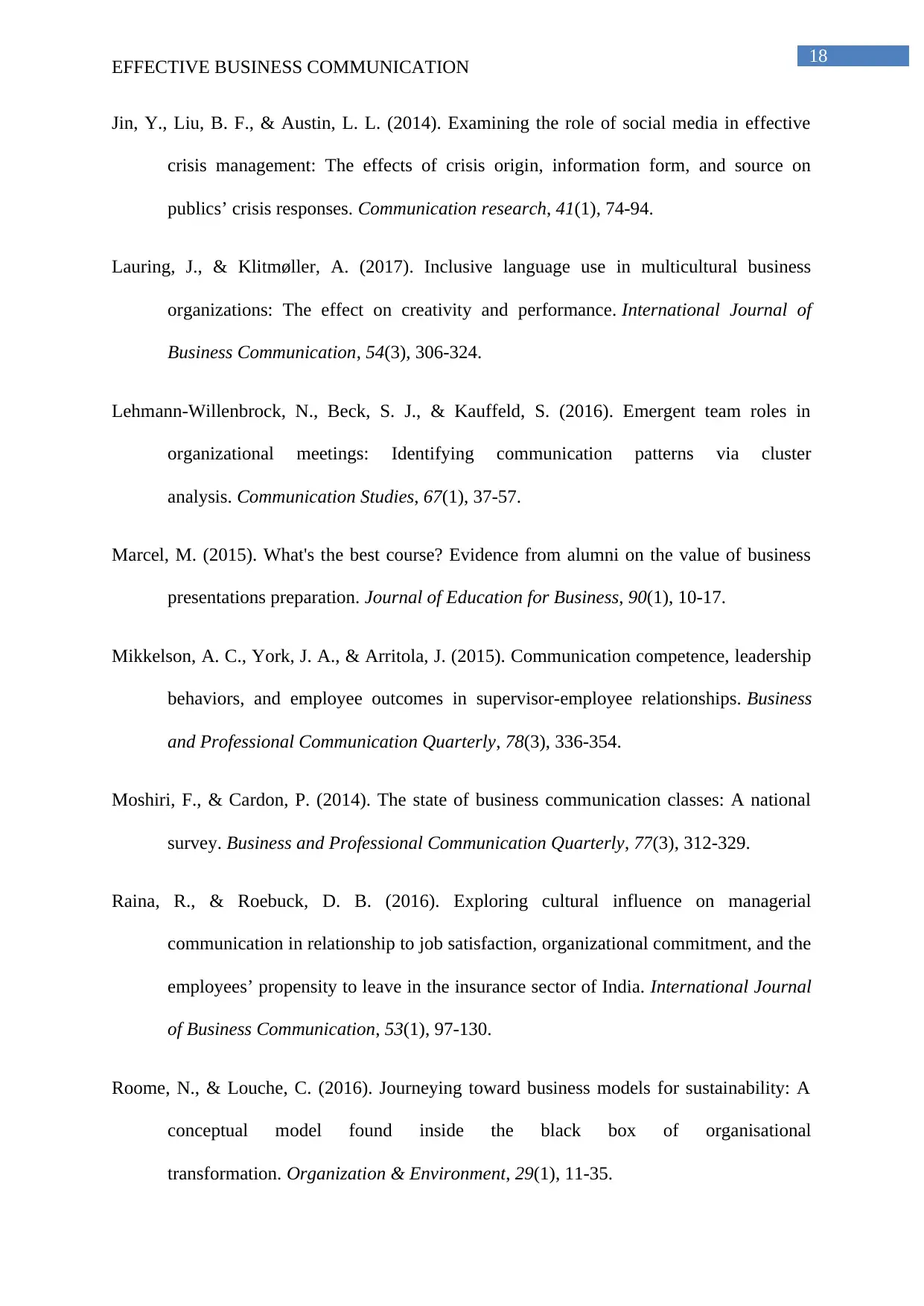
18
EFFECTIVE BUSINESS COMMUNICATION
Jin, Y., Liu, B. F., & Austin, L. L. (2014). Examining the role of social media in effective
crisis management: The effects of crisis origin, information form, and source on
publics’ crisis responses. Communication research, 41(1), 74-94.
Lauring, J., & Klitmøller, A. (2017). Inclusive language use in multicultural business
organizations: The effect on creativity and performance. International Journal of
Business Communication, 54(3), 306-324.
Lehmann-Willenbrock, N., Beck, S. J., & Kauffeld, S. (2016). Emergent team roles in
organizational meetings: Identifying communication patterns via cluster
analysis. Communication Studies, 67(1), 37-57.
Marcel, M. (2015). What's the best course? Evidence from alumni on the value of business
presentations preparation. Journal of Education for Business, 90(1), 10-17.
Mikkelson, A. C., York, J. A., & Arritola, J. (2015). Communication competence, leadership
behaviors, and employee outcomes in supervisor-employee relationships. Business
and Professional Communication Quarterly, 78(3), 336-354.
Moshiri, F., & Cardon, P. (2014). The state of business communication classes: A national
survey. Business and Professional Communication Quarterly, 77(3), 312-329.
Raina, R., & Roebuck, D. B. (2016). Exploring cultural influence on managerial
communication in relationship to job satisfaction, organizational commitment, and the
employees’ propensity to leave in the insurance sector of India. International Journal
of Business Communication, 53(1), 97-130.
Roome, N., & Louche, C. (2016). Journeying toward business models for sustainability: A
conceptual model found inside the black box of organisational
transformation. Organization & Environment, 29(1), 11-35.
EFFECTIVE BUSINESS COMMUNICATION
Jin, Y., Liu, B. F., & Austin, L. L. (2014). Examining the role of social media in effective
crisis management: The effects of crisis origin, information form, and source on
publics’ crisis responses. Communication research, 41(1), 74-94.
Lauring, J., & Klitmøller, A. (2017). Inclusive language use in multicultural business
organizations: The effect on creativity and performance. International Journal of
Business Communication, 54(3), 306-324.
Lehmann-Willenbrock, N., Beck, S. J., & Kauffeld, S. (2016). Emergent team roles in
organizational meetings: Identifying communication patterns via cluster
analysis. Communication Studies, 67(1), 37-57.
Marcel, M. (2015). What's the best course? Evidence from alumni on the value of business
presentations preparation. Journal of Education for Business, 90(1), 10-17.
Mikkelson, A. C., York, J. A., & Arritola, J. (2015). Communication competence, leadership
behaviors, and employee outcomes in supervisor-employee relationships. Business
and Professional Communication Quarterly, 78(3), 336-354.
Moshiri, F., & Cardon, P. (2014). The state of business communication classes: A national
survey. Business and Professional Communication Quarterly, 77(3), 312-329.
Raina, R., & Roebuck, D. B. (2016). Exploring cultural influence on managerial
communication in relationship to job satisfaction, organizational commitment, and the
employees’ propensity to leave in the insurance sector of India. International Journal
of Business Communication, 53(1), 97-130.
Roome, N., & Louche, C. (2016). Journeying toward business models for sustainability: A
conceptual model found inside the black box of organisational
transformation. Organization & Environment, 29(1), 11-35.
Paraphrase This Document
Need a fresh take? Get an instant paraphrase of this document with our AI Paraphraser
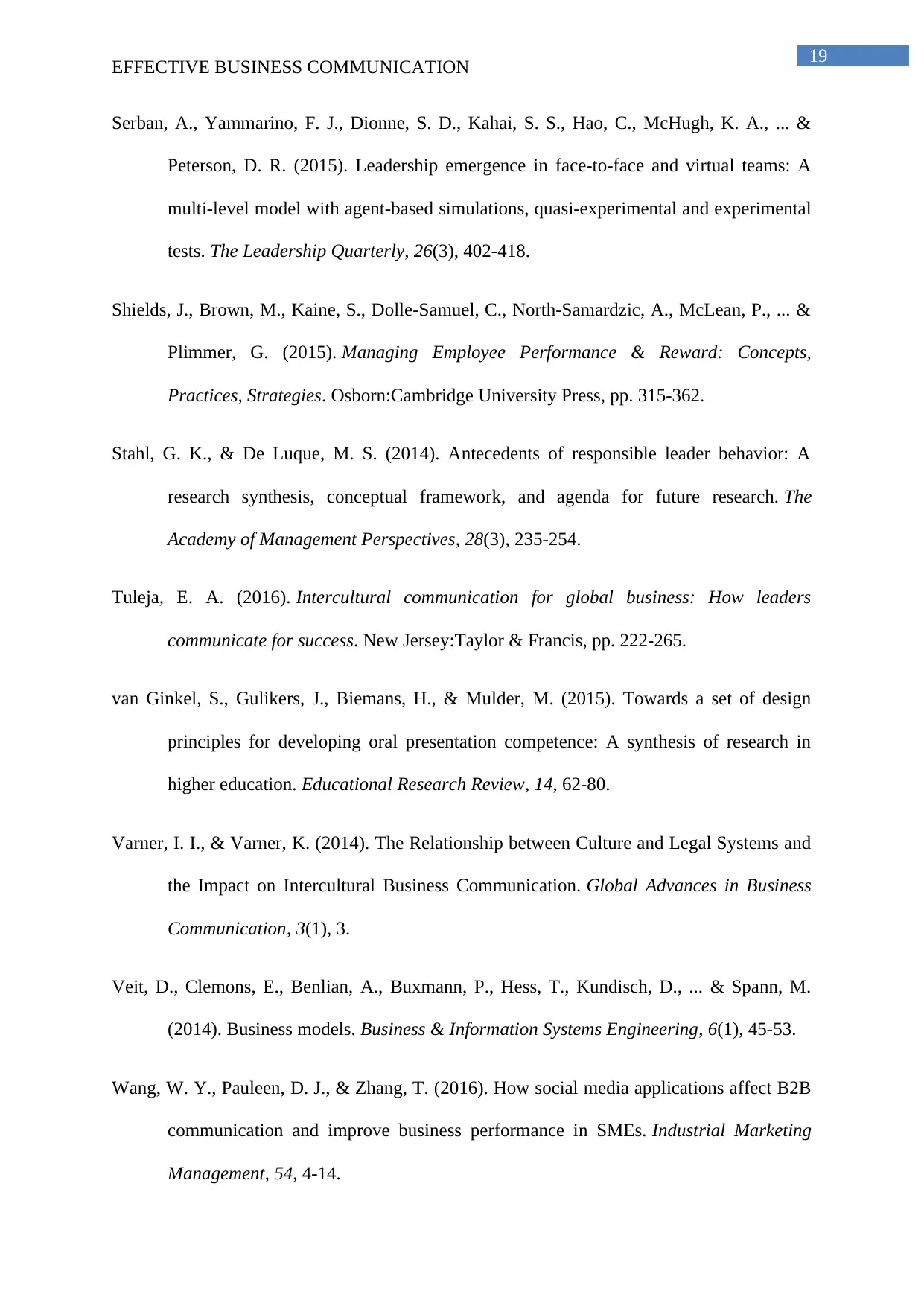
19
EFFECTIVE BUSINESS COMMUNICATION
Serban, A., Yammarino, F. J., Dionne, S. D., Kahai, S. S., Hao, C., McHugh, K. A., ... &
Peterson, D. R. (2015). Leadership emergence in face-to-face and virtual teams: A
multi-level model with agent-based simulations, quasi-experimental and experimental
tests. The Leadership Quarterly, 26(3), 402-418.
Shields, J., Brown, M., Kaine, S., Dolle-Samuel, C., North-Samardzic, A., McLean, P., ... &
Plimmer, G. (2015). Managing Employee Performance & Reward: Concepts,
Practices, Strategies. Osborn:Cambridge University Press, pp. 315-362.
Stahl, G. K., & De Luque, M. S. (2014). Antecedents of responsible leader behavior: A
research synthesis, conceptual framework, and agenda for future research. The
Academy of Management Perspectives, 28(3), 235-254.
Tuleja, E. A. (2016). Intercultural communication for global business: How leaders
communicate for success. New Jersey:Taylor & Francis, pp. 222-265.
van Ginkel, S., Gulikers, J., Biemans, H., & Mulder, M. (2015). Towards a set of design
principles for developing oral presentation competence: A synthesis of research in
higher education. Educational Research Review, 14, 62-80.
Varner, I. I., & Varner, K. (2014). The Relationship between Culture and Legal Systems and
the Impact on Intercultural Business Communication. Global Advances in Business
Communication, 3(1), 3.
Veit, D., Clemons, E., Benlian, A., Buxmann, P., Hess, T., Kundisch, D., ... & Spann, M.
(2014). Business models. Business & Information Systems Engineering, 6(1), 45-53.
Wang, W. Y., Pauleen, D. J., & Zhang, T. (2016). How social media applications affect B2B
communication and improve business performance in SMEs. Industrial Marketing
Management, 54, 4-14.
EFFECTIVE BUSINESS COMMUNICATION
Serban, A., Yammarino, F. J., Dionne, S. D., Kahai, S. S., Hao, C., McHugh, K. A., ... &
Peterson, D. R. (2015). Leadership emergence in face-to-face and virtual teams: A
multi-level model with agent-based simulations, quasi-experimental and experimental
tests. The Leadership Quarterly, 26(3), 402-418.
Shields, J., Brown, M., Kaine, S., Dolle-Samuel, C., North-Samardzic, A., McLean, P., ... &
Plimmer, G. (2015). Managing Employee Performance & Reward: Concepts,
Practices, Strategies. Osborn:Cambridge University Press, pp. 315-362.
Stahl, G. K., & De Luque, M. S. (2014). Antecedents of responsible leader behavior: A
research synthesis, conceptual framework, and agenda for future research. The
Academy of Management Perspectives, 28(3), 235-254.
Tuleja, E. A. (2016). Intercultural communication for global business: How leaders
communicate for success. New Jersey:Taylor & Francis, pp. 222-265.
van Ginkel, S., Gulikers, J., Biemans, H., & Mulder, M. (2015). Towards a set of design
principles for developing oral presentation competence: A synthesis of research in
higher education. Educational Research Review, 14, 62-80.
Varner, I. I., & Varner, K. (2014). The Relationship between Culture and Legal Systems and
the Impact on Intercultural Business Communication. Global Advances in Business
Communication, 3(1), 3.
Veit, D., Clemons, E., Benlian, A., Buxmann, P., Hess, T., Kundisch, D., ... & Spann, M.
(2014). Business models. Business & Information Systems Engineering, 6(1), 45-53.
Wang, W. Y., Pauleen, D. J., & Zhang, T. (2016). How social media applications affect B2B
communication and improve business performance in SMEs. Industrial Marketing
Management, 54, 4-14.
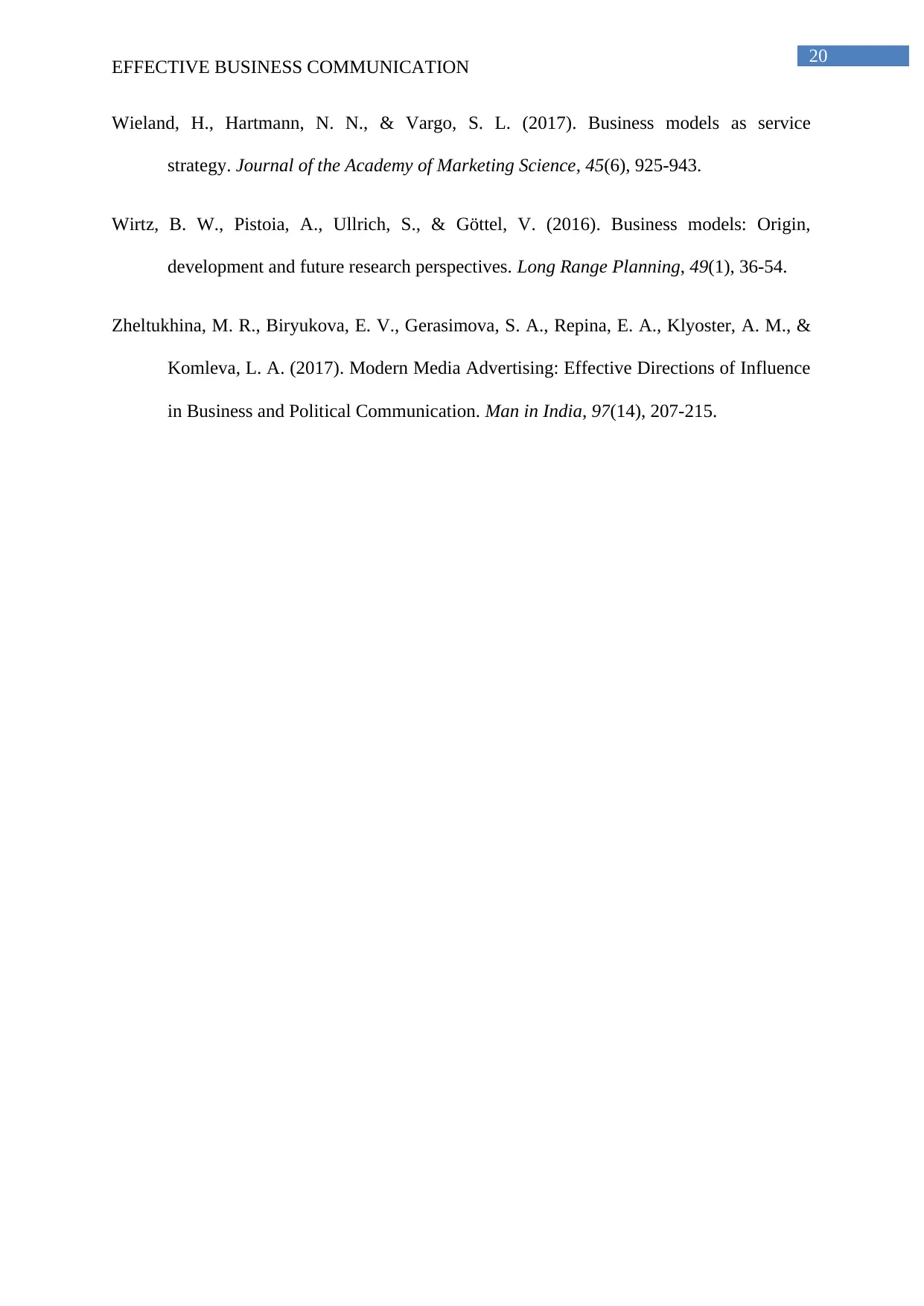
20
EFFECTIVE BUSINESS COMMUNICATION
Wieland, H., Hartmann, N. N., & Vargo, S. L. (2017). Business models as service
strategy. Journal of the Academy of Marketing Science, 45(6), 925-943.
Wirtz, B. W., Pistoia, A., Ullrich, S., & Göttel, V. (2016). Business models: Origin,
development and future research perspectives. Long Range Planning, 49(1), 36-54.
Zheltukhina, M. R., Biryukova, E. V., Gerasimova, S. A., Repina, E. A., Klyoster, A. M., &
Komleva, L. A. (2017). Modern Media Advertising: Effective Directions of Influence
in Business and Political Communication. Man in India, 97(14), 207-215.
EFFECTIVE BUSINESS COMMUNICATION
Wieland, H., Hartmann, N. N., & Vargo, S. L. (2017). Business models as service
strategy. Journal of the Academy of Marketing Science, 45(6), 925-943.
Wirtz, B. W., Pistoia, A., Ullrich, S., & Göttel, V. (2016). Business models: Origin,
development and future research perspectives. Long Range Planning, 49(1), 36-54.
Zheltukhina, M. R., Biryukova, E. V., Gerasimova, S. A., Repina, E. A., Klyoster, A. M., &
Komleva, L. A. (2017). Modern Media Advertising: Effective Directions of Influence
in Business and Political Communication. Man in India, 97(14), 207-215.
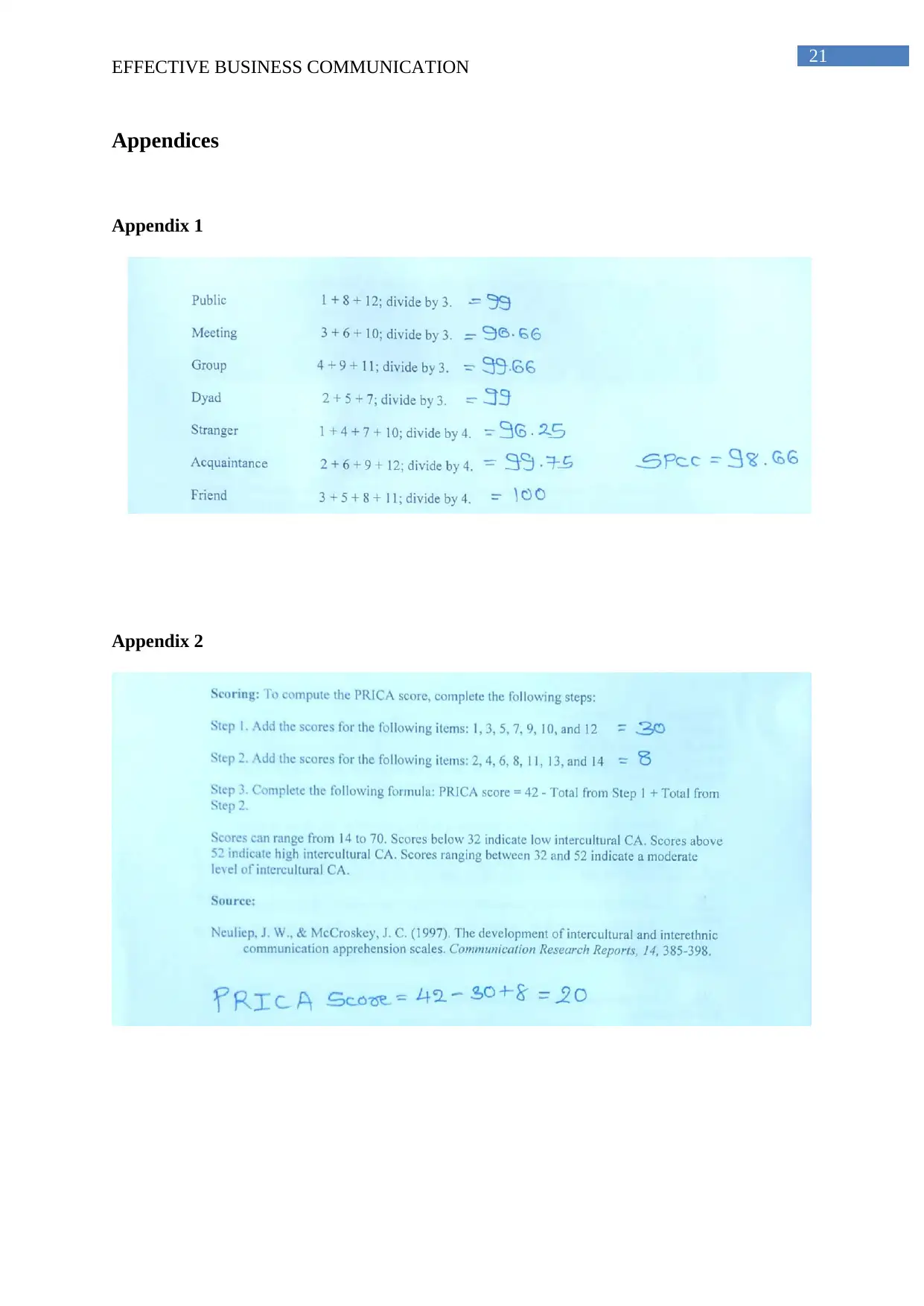
21
EFFECTIVE BUSINESS COMMUNICATION
Appendices
Appendix 1
Appendix 2
EFFECTIVE BUSINESS COMMUNICATION
Appendices
Appendix 1
Appendix 2
Secure Best Marks with AI Grader
Need help grading? Try our AI Grader for instant feedback on your assignments.
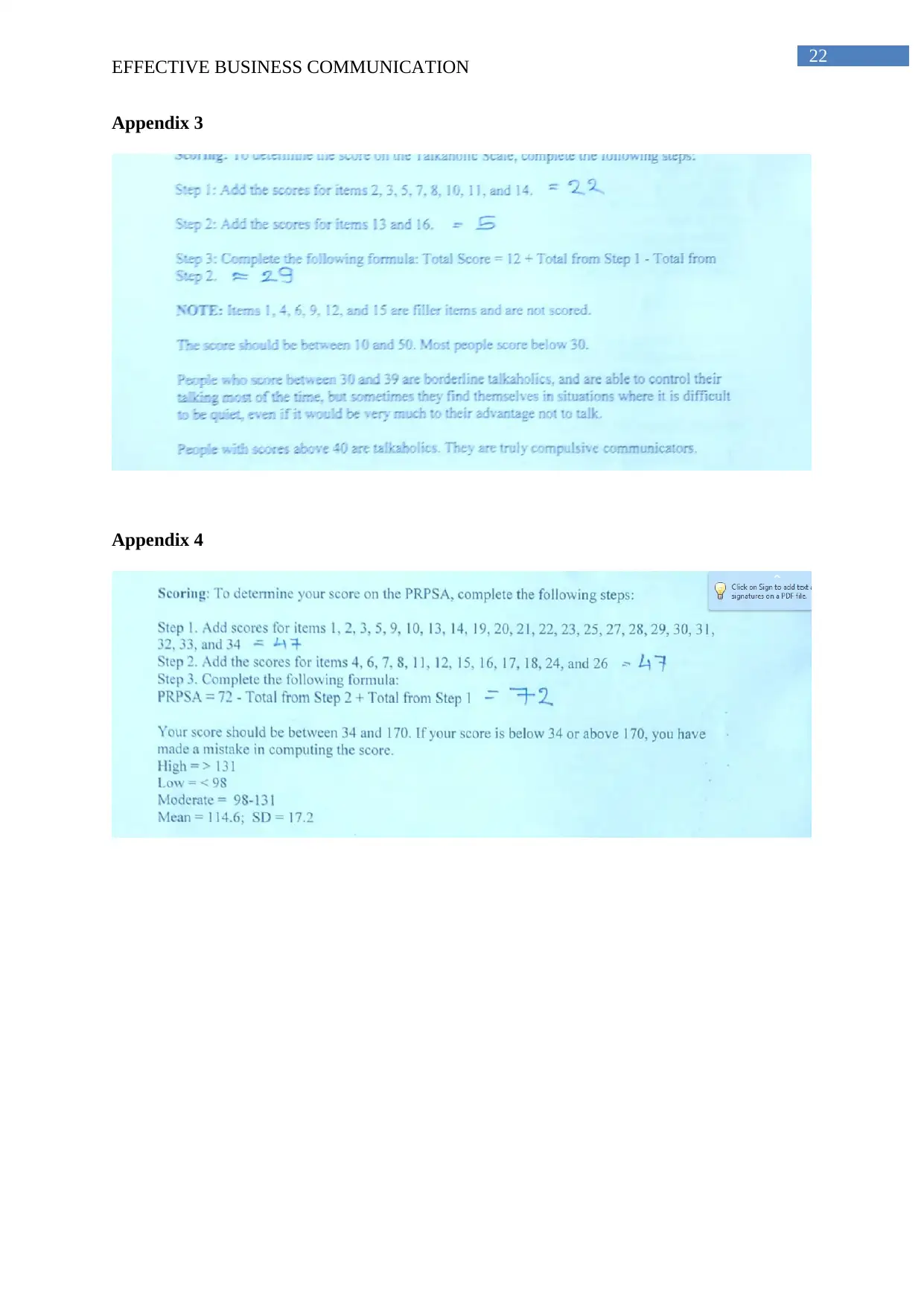
22
EFFECTIVE BUSINESS COMMUNICATION
Appendix 3
Appendix 4
EFFECTIVE BUSINESS COMMUNICATION
Appendix 3
Appendix 4
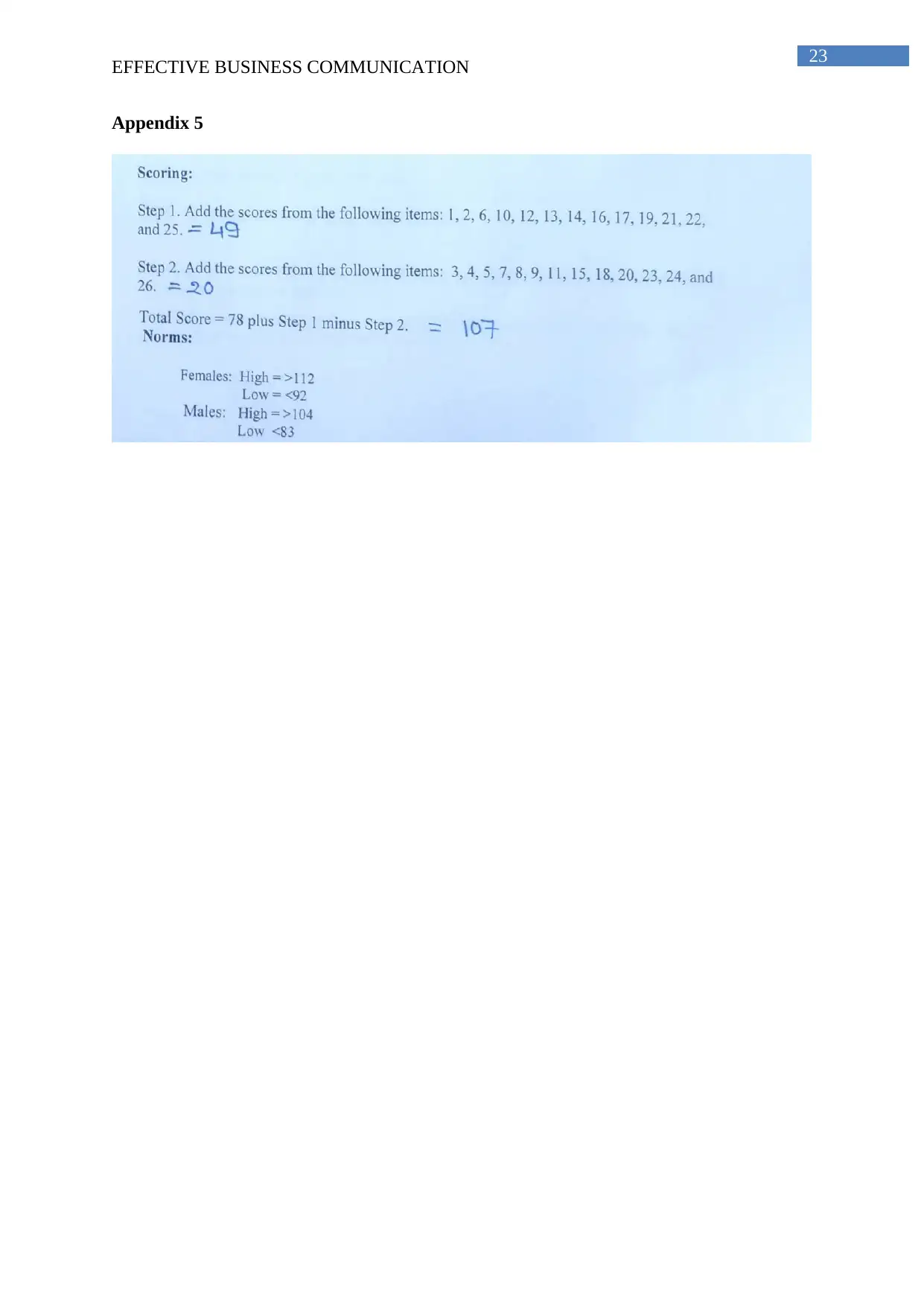
23
EFFECTIVE BUSINESS COMMUNICATION
Appendix 5
EFFECTIVE BUSINESS COMMUNICATION
Appendix 5
1 out of 24
Your All-in-One AI-Powered Toolkit for Academic Success.
+13062052269
info@desklib.com
Available 24*7 on WhatsApp / Email
![[object Object]](/_next/static/media/star-bottom.7253800d.svg)
Unlock your academic potential
© 2024 | Zucol Services PVT LTD | All rights reserved.


